-
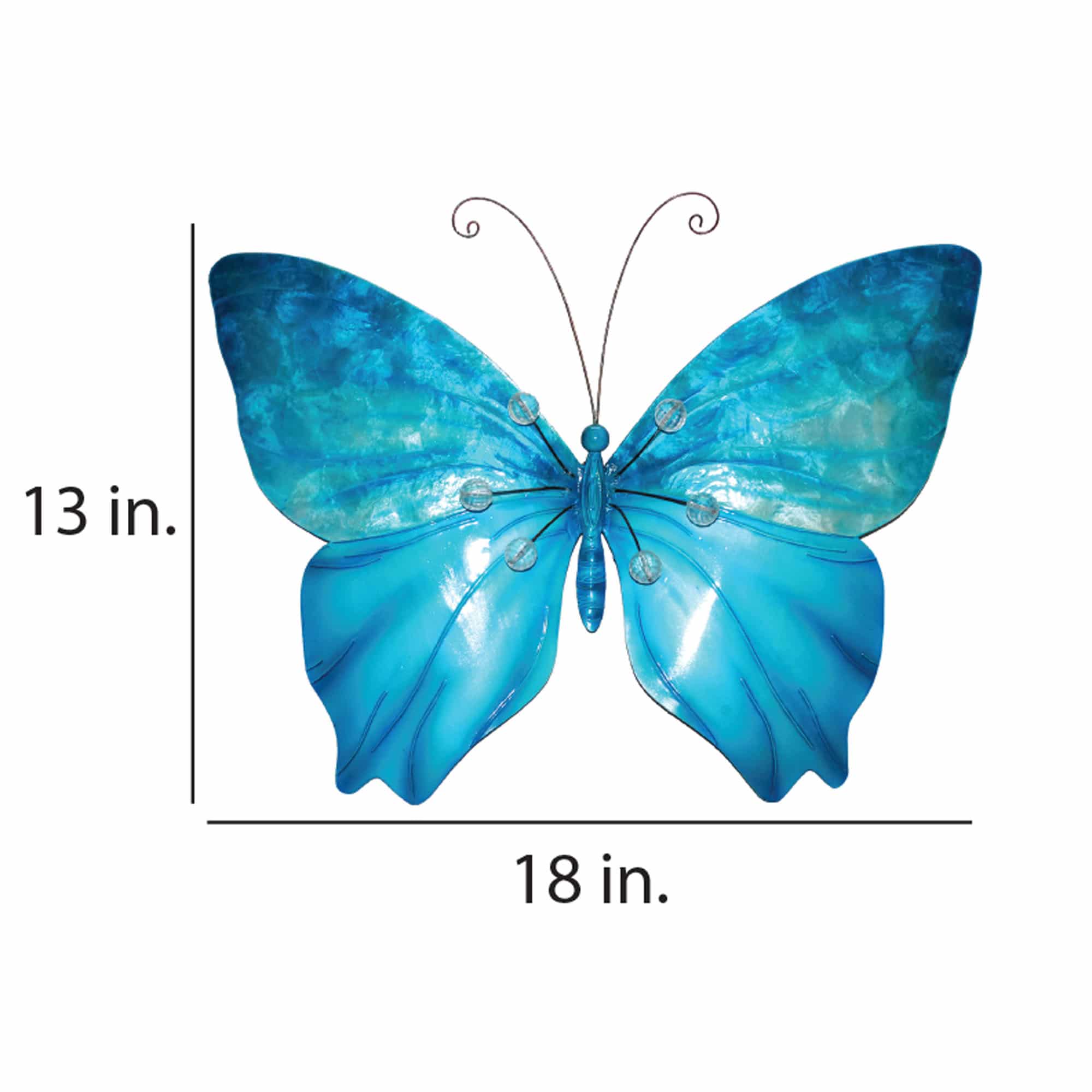
 This piece showcases a bright, blue body strong in aqua tones. The upper wings glisten from the inlay of shell work; each shell absorbing and reflecting light differently than its neighbor. The lower wings contrast with a softer, satin, blue finish. As added detail, the metal in the lower wing is pressed to represent the artist's view of the wing's components. Beads radiate from the center of the butterfly, almost making it feel as if this butterfly is transforming from a flower into its animal form. The basic frame of the butterfly is created using tin, which is powder-coated with a black finish and makes this piece safe to use outdoors. The edges of the frame are reinforced using thicker tin wire. The front of this piece is adorned in areas with capiz shell, an oyster native to the Philippines, before being hand-painted and sealed with a water-based sealant. The primary purpose of this oyster to provide a source of food, however, the shell is a sustainable by-product that can be used for decoration. The capiz shell subtly replicates the reflective qualities of butterflies in nature. The entire piece is lightweight and has an eyelet in the back allowing it to be hung using a finishing nail, command strip, or a push pin. Due to it being a natural material, the organic colors of capiz come through as tans and browns underneath the paint.
This piece showcases a bright, blue body strong in aqua tones. The upper wings glisten from the inlay of shell work; each shell absorbing and reflecting light differently than its neighbor. The lower wings contrast with a softer, satin, blue finish. As added detail, the metal in the lower wing is pressed to represent the artist's view of the wing's components. Beads radiate from the center of the butterfly, almost making it feel as if this butterfly is transforming from a flower into its animal form. The basic frame of the butterfly is created using tin, which is powder-coated with a black finish and makes this piece safe to use outdoors. The edges of the frame are reinforced using thicker tin wire. The front of this piece is adorned in areas with capiz shell, an oyster native to the Philippines, before being hand-painted and sealed with a water-based sealant. The primary purpose of this oyster to provide a source of food, however, the shell is a sustainable by-product that can be used for decoration. The capiz shell subtly replicates the reflective qualities of butterflies in nature. The entire piece is lightweight and has an eyelet in the back allowing it to be hung using a finishing nail, command strip, or a push pin. Due to it being a natural material, the organic colors of capiz come through as tans and browns underneath the paint. -

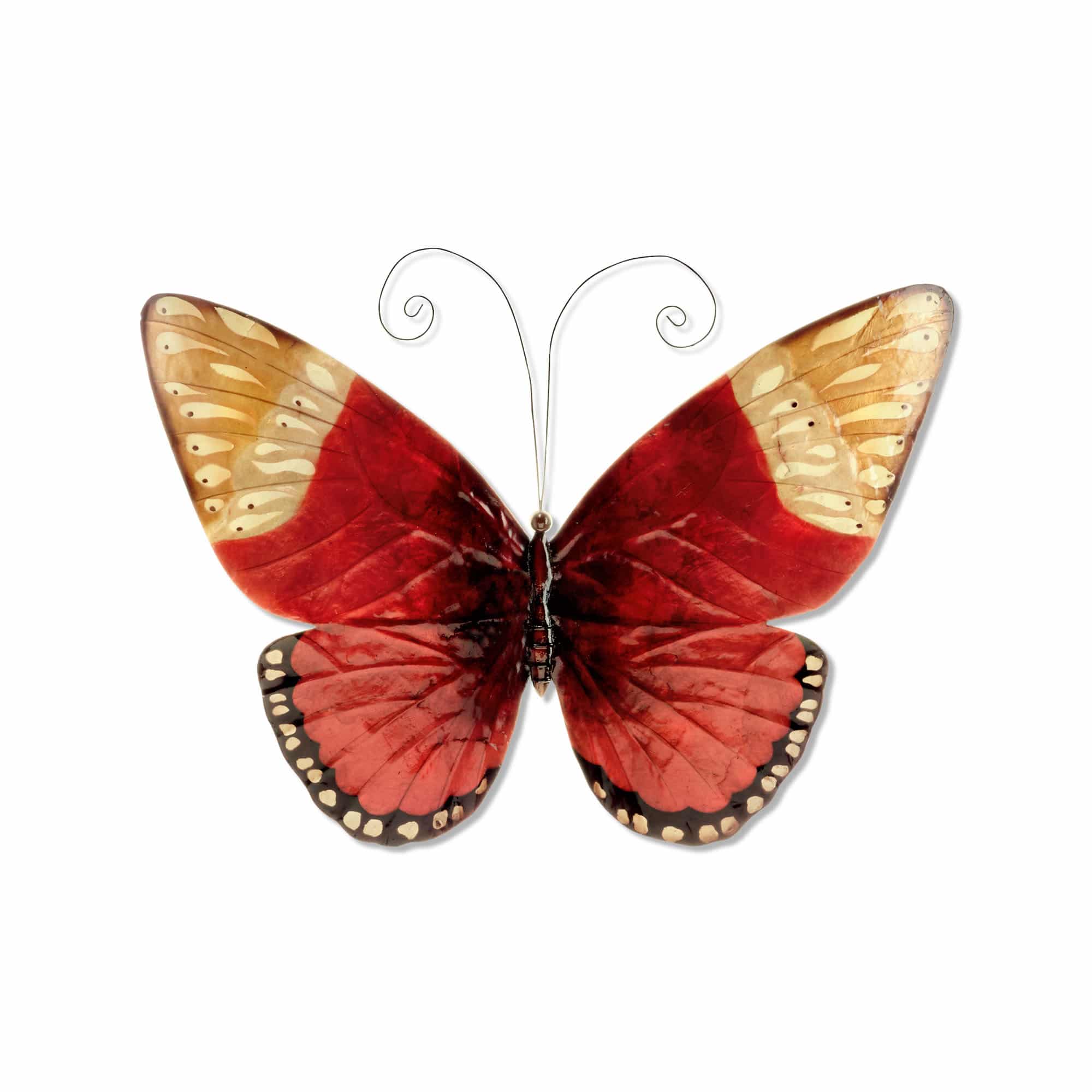
This butterfly is large and bold with its striking bright red body. But this butterfly isn't mono-colored. Instead the artist uses different shading techniques and mother of pearl oyster shell to bring in depth as well as strong color. The artist further enhances the butterfly by adding brown feathering to the wing-tips.
The basic frame of the butterfly is created using tin, which is powder-coated with a black finish and makes this piece safe to use outdoors. The edges of the frame are reinforced using thicker tin wire. The front of this piece is adorned in areas with capiz shell, an oyster native to the Philippines, before being hand-painted and sealed with a water-based sealant. The primary purpose of this oyster to provide a source of food, however, the shell is a sustainable by-product that can be used for decoration. The capiz shell subtly replicates the reflective qualities of butterflies in nature. The entire piece is lightweight and has an eyelet in the back allowing it to be hung using a finishing nail, command strip, or a push pin. Due to it being a natural material, the organic colors of capiz come through as tans and browns underneath the paint.
-
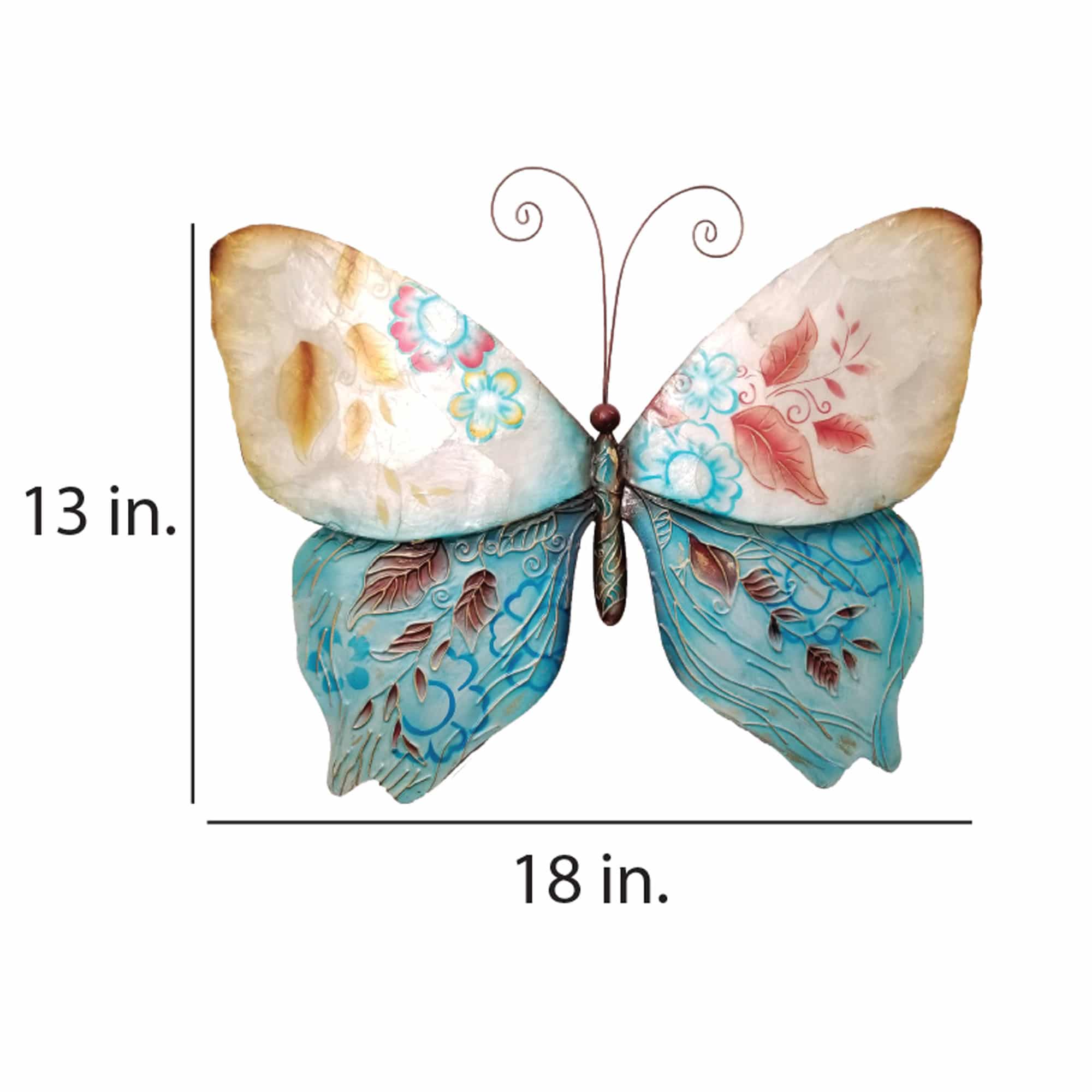
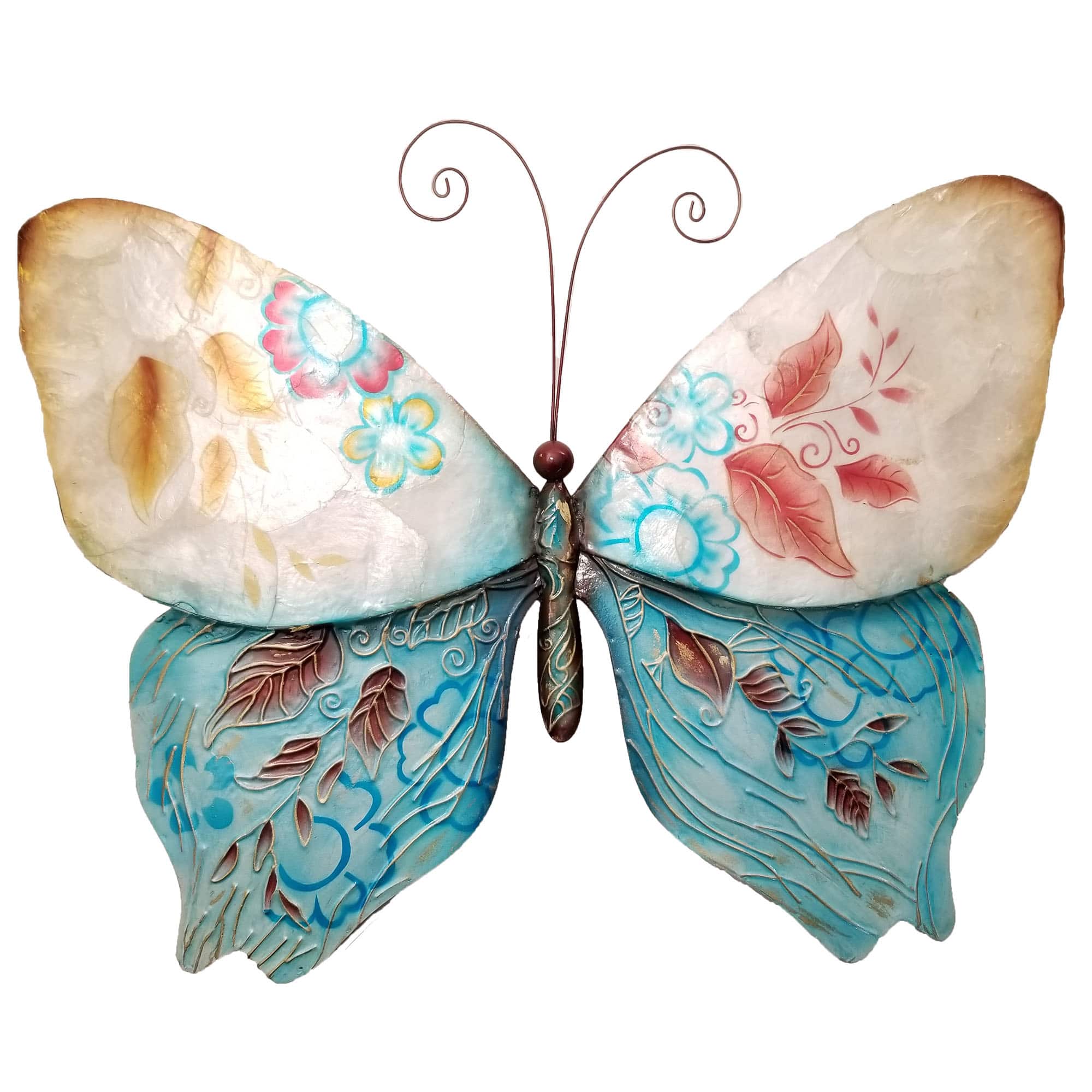 Using intricate design and cool colors, this butterfly is sophisticated with its retro leaf and flower patterns. The upper wings are adorned with capiz shell and the flower patterns are painted lightly, complementing the translucent color seen in the natural butterfly. The lower wings are constructed from tin, textured, colored with a burst of turquoise and accented with golds and reds. Great for nearly all decor styles, this piece works great in contemporary, modern, traditional, and farm house settings The basic frame of the butterfly is created using tin, which is powder-coated with a black finish and makes this piece safe to use outdoors. The edges of the frame are reinforced using thicker tin wire. The front of this piece is adorned in areas with capiz shell, an oyster native to the Philippines, before being hand-painted and sealed with a water-based sealant. The primary purpose of this oyster to provide a source of food, however, the shell is a sustainable by-product that can be used for decoration. The capiz shell subtly replicates the reflective qualities of butterflies in nature. The entire piece is lightweight and has an eyelet in the back allowing it to be hung using a finishing nail, command strip, or a push pin. Due to it being a natural material, the organic colors of capiz come through as tans and browns underneath the paint.
Using intricate design and cool colors, this butterfly is sophisticated with its retro leaf and flower patterns. The upper wings are adorned with capiz shell and the flower patterns are painted lightly, complementing the translucent color seen in the natural butterfly. The lower wings are constructed from tin, textured, colored with a burst of turquoise and accented with golds and reds. Great for nearly all decor styles, this piece works great in contemporary, modern, traditional, and farm house settings The basic frame of the butterfly is created using tin, which is powder-coated with a black finish and makes this piece safe to use outdoors. The edges of the frame are reinforced using thicker tin wire. The front of this piece is adorned in areas with capiz shell, an oyster native to the Philippines, before being hand-painted and sealed with a water-based sealant. The primary purpose of this oyster to provide a source of food, however, the shell is a sustainable by-product that can be used for decoration. The capiz shell subtly replicates the reflective qualities of butterflies in nature. The entire piece is lightweight and has an eyelet in the back allowing it to be hung using a finishing nail, command strip, or a push pin. Due to it being a natural material, the organic colors of capiz come through as tans and browns underneath the paint. -
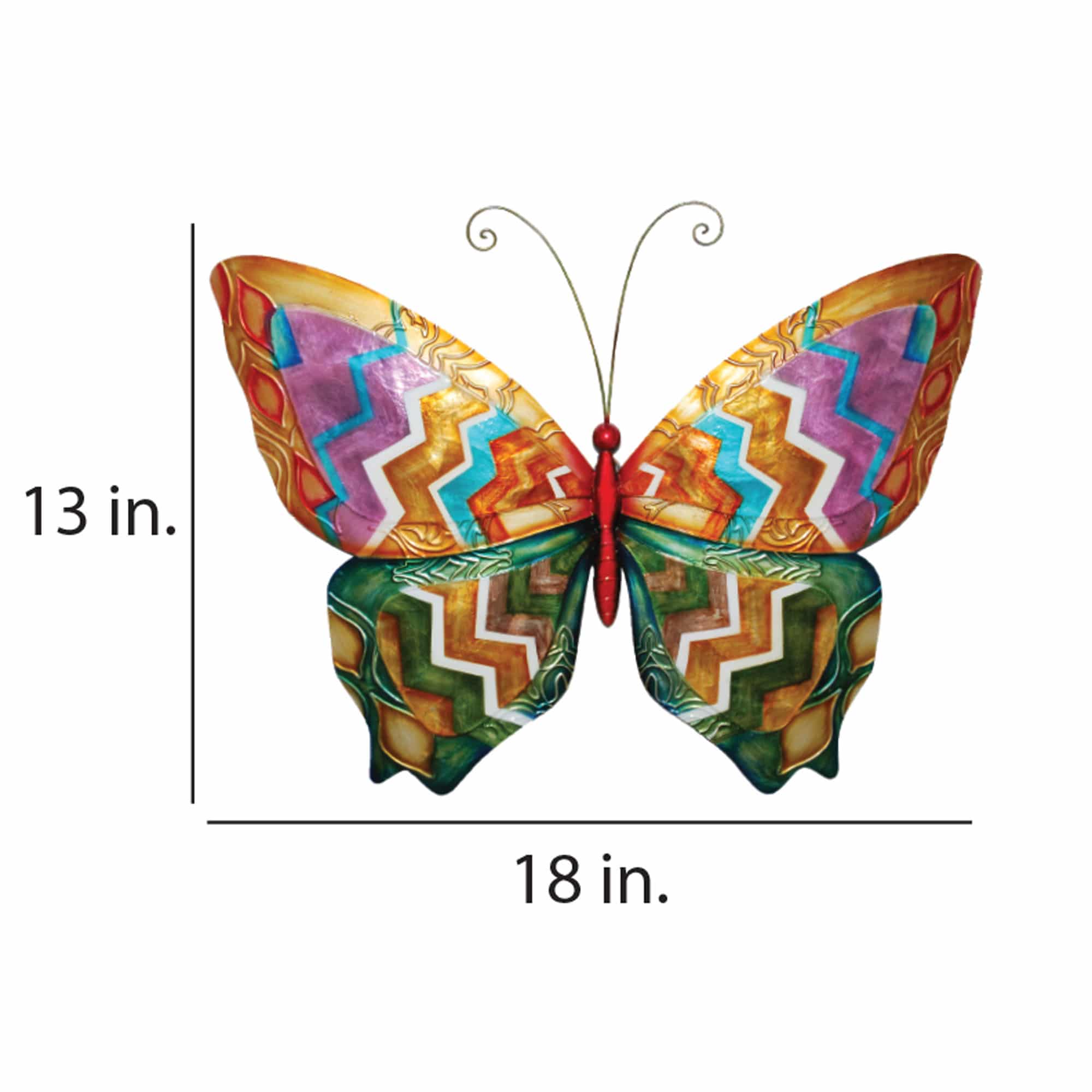
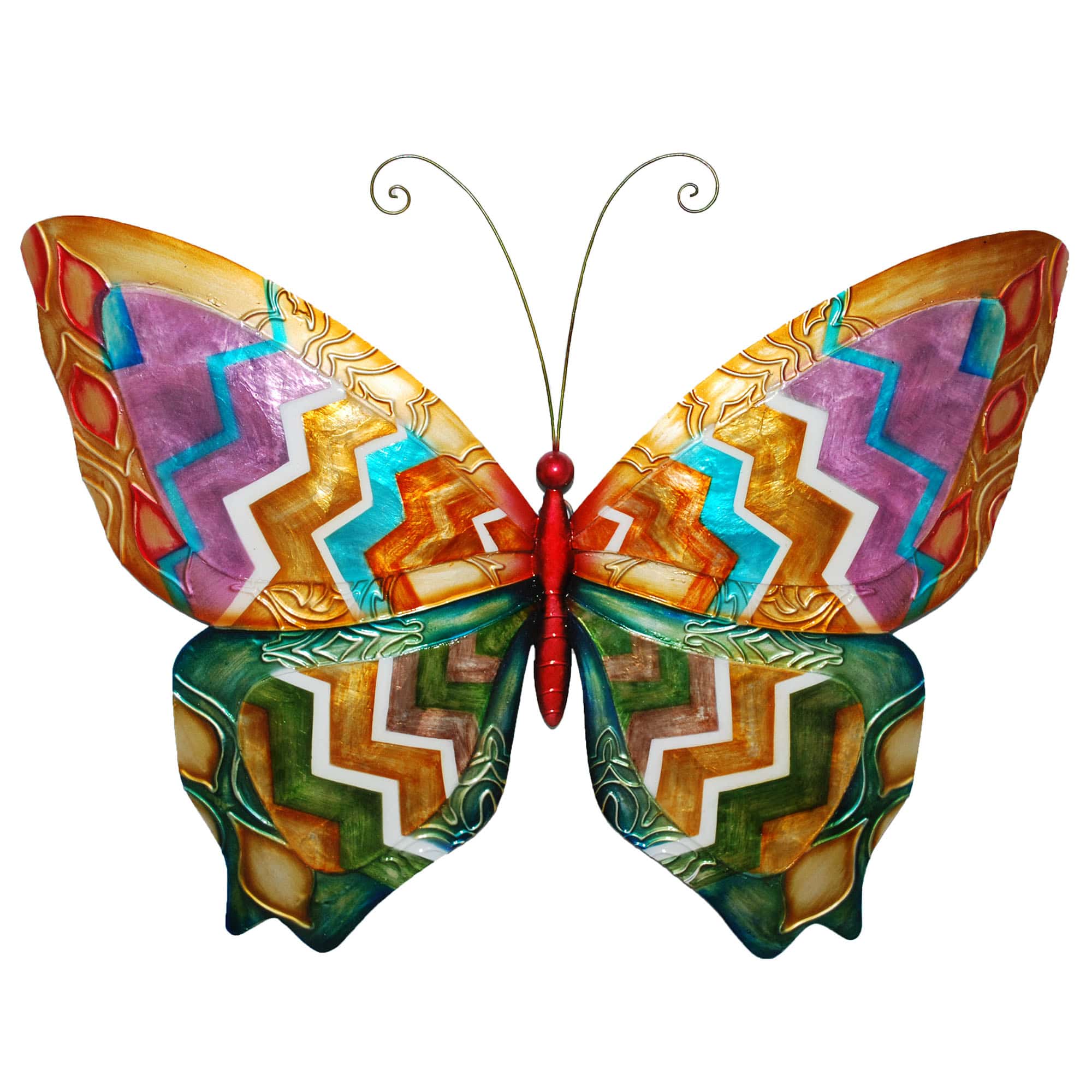
This butterfly shows sharp, bold, beautiful contrasting colors. Using a stylized design, the artist uses shimmering capiz shell and radiating zig zag patterns to create warmth and excitement. These bright colors are complimented by a subtle texture set within the metal work.
The basic frame of the butterfly is created using tin, which is powder-coated with a black finish and makes this piece safe to use outdoors. The edges of the frame are reinforced using thicker tin wire. The front of this piece is adorned in areas with capiz shell, an oyster native to the Philippines, before being hand-painted and sealed with a water-based sealant. The primary purpose of this oyster to provide a source of food, however, the shell is a sustainable by-product that can be used for decoration. The capiz shell subtly replicates the reflective qualities of butterflies in nature. The entire piece is lightweight and has an eyelet in the back allowing it to be hung using a finishing nail, command strip, or a push pin. Due to it being a natural material, the organic colors of capiz come through as tans and browns underneath the paint.
-
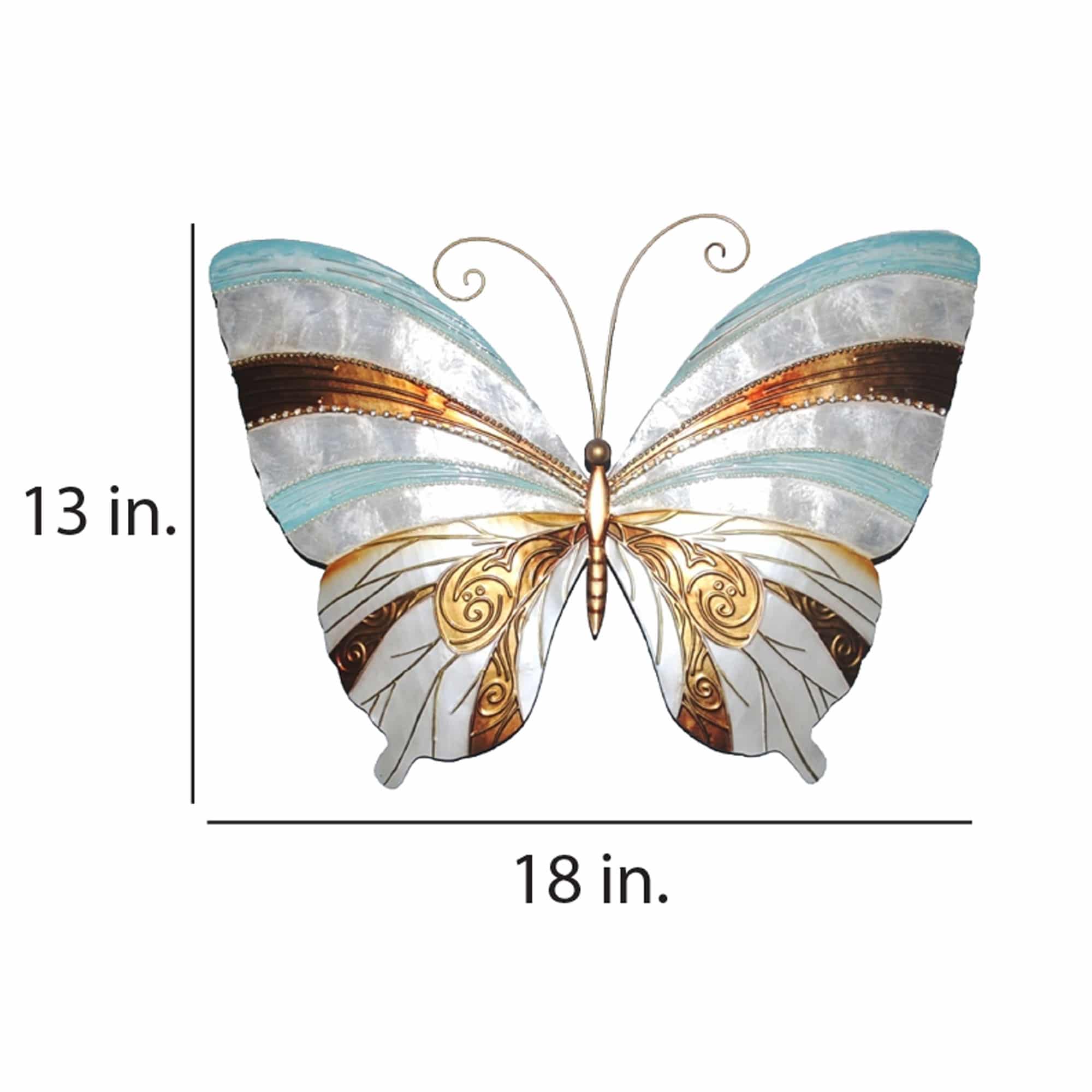
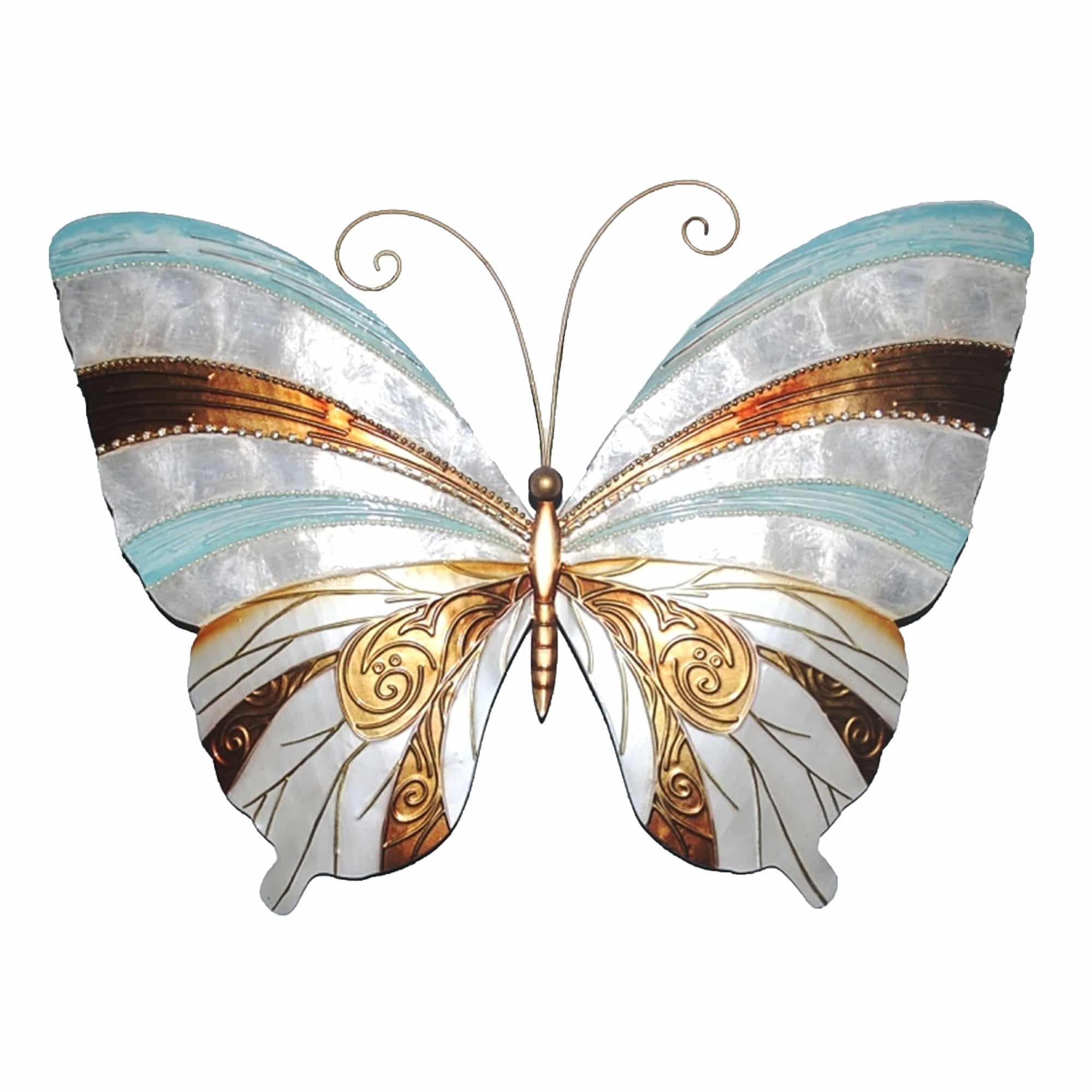
With warm copper tones and elegant, contemporary soft blues, this butterfly hits all the right trends. The artist heightens this feel with capiz shell and shimmering beads. The hand-painted finish flows gracefully along clean lines radiating outwards towards its wingtips.
The basic frame of the butterfly is created using tin, which is powder-coated with a black finish and makes this piece safe to use outdoors. The edges of the frame are reinforced using thicker tin wire. The front of this piece is adorned in areas with capiz shell, an oyster native to the Philippines, before being hand-painted and sealed with a water-based sealant. The primary purpose of this oyster to provide a source of food, however, the shell is a sustainable by-product that can be used for decoration. The capiz shell subtly replicates the reflective qualities of butterflies in nature. The entire piece is lightweight and has an eyelet in the back allowing it to be hung using a finishing nail, command strip, or a push pin. Due to it being a natural material, the organic colors of capiz come through as tans and browns underneath the paint.
-
-66%
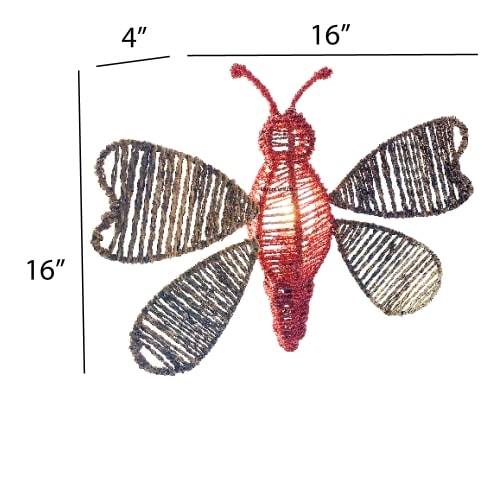
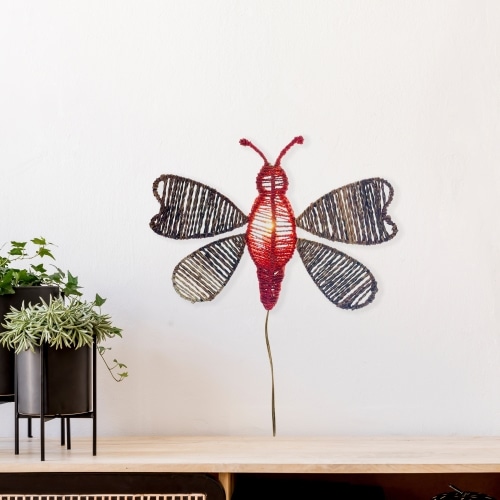 This butterfly is large and bold with its striking bright red body. But this butterfly isn't mono-colored. Instead, the artist uses natural earth tones within its wings to create contrast and warmth. This piece adds fun on its own but can have even larger impact if placed in a group with a few friends! The butterfly's wings are comprised of natural abaca rope handwoven into a wrought iron frame. The head and body is made of abaca twine, stained, and then handwoven into the same wrought iron fame, emphasizing the contrast between the body and wings. Abaca is a fiber of a plant that is related to the banana plant. It bears no fruit, but it can continuously grow from the same roots similar to native grasses. The open weaving allows for ambient light to show through providing functional light. Also included is a plug with an inline switch for easy use.
This butterfly is large and bold with its striking bright red body. But this butterfly isn't mono-colored. Instead, the artist uses natural earth tones within its wings to create contrast and warmth. This piece adds fun on its own but can have even larger impact if placed in a group with a few friends! The butterfly's wings are comprised of natural abaca rope handwoven into a wrought iron frame. The head and body is made of abaca twine, stained, and then handwoven into the same wrought iron fame, emphasizing the contrast between the body and wings. Abaca is a fiber of a plant that is related to the banana plant. It bears no fruit, but it can continuously grow from the same roots similar to native grasses. The open weaving allows for ambient light to show through providing functional light. Also included is a plug with an inline switch for easy use. -
-66%
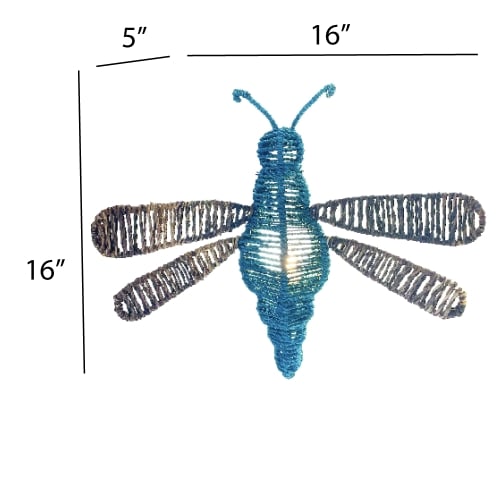
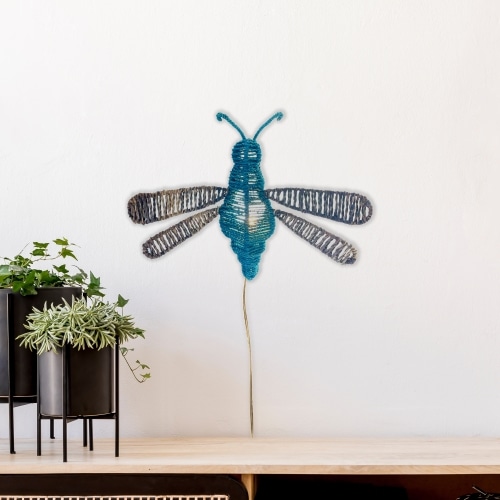 Reflecting the natural aquas and blues of the nearly translucent dragonfly, the artist uses a base of sea blue dyed abaca weave to embody the almost ephemeral structure. The wings feature a natural abaca rope mimicking the texture of a dragonfly's organic wing structure. This piece adds fun on its own but can have even larger impact if placed in a group with a few friends! The dragonfly's wings are comprised of natural abaca rope handwoven into a wrought iron frame. The head and body is made of abaca twine, stained, and then handwoven into the same wrought iron fame, emphasizing the contrast between the body and wings. Abaca is a fiber of a plant that is related to the banana plant. It bears no fruit, but it can continuously grow from the same roots similar to native grasses. The open weaving allows for ambient light to show through providing functional light. Also included is a plug with an inline switch for easy use.
Reflecting the natural aquas and blues of the nearly translucent dragonfly, the artist uses a base of sea blue dyed abaca weave to embody the almost ephemeral structure. The wings feature a natural abaca rope mimicking the texture of a dragonfly's organic wing structure. This piece adds fun on its own but can have even larger impact if placed in a group with a few friends! The dragonfly's wings are comprised of natural abaca rope handwoven into a wrought iron frame. The head and body is made of abaca twine, stained, and then handwoven into the same wrought iron fame, emphasizing the contrast between the body and wings. Abaca is a fiber of a plant that is related to the banana plant. It bears no fruit, but it can continuously grow from the same roots similar to native grasses. The open weaving allows for ambient light to show through providing functional light. Also included is a plug with an inline switch for easy use. -
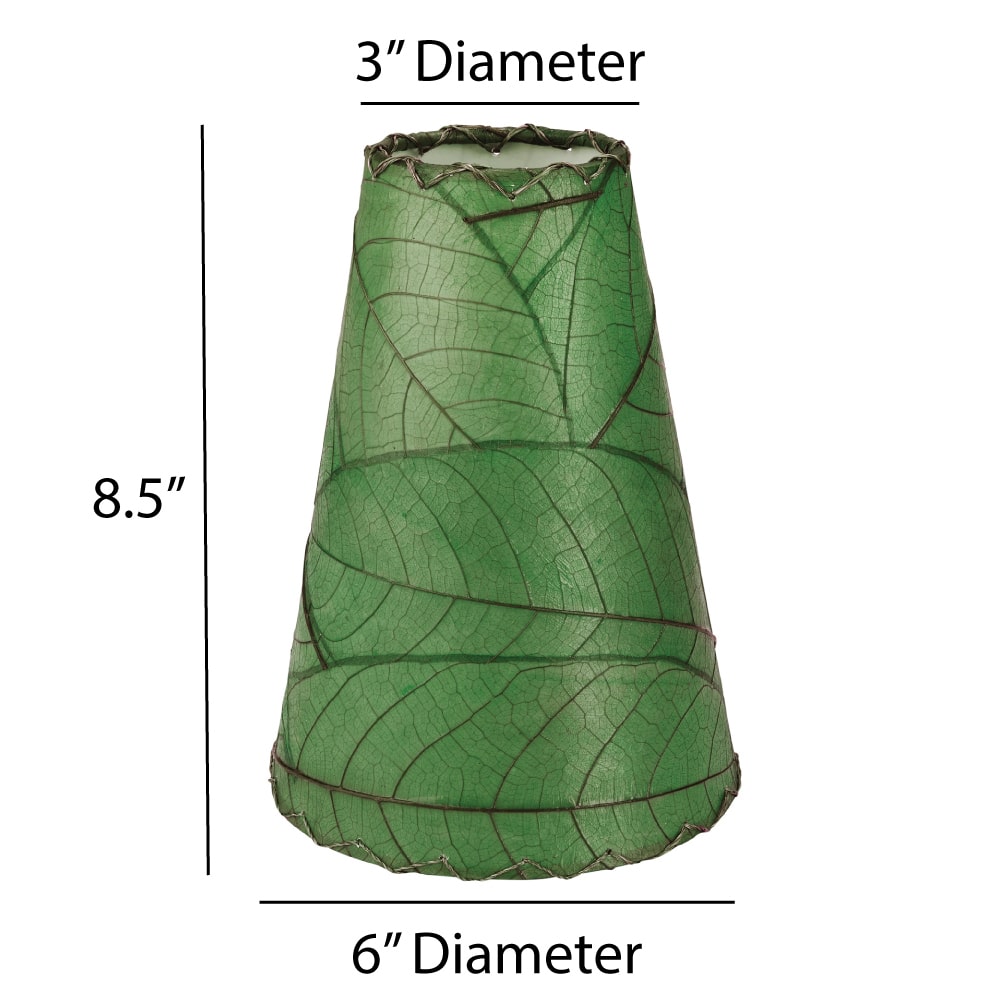
 Replacement Shade Only The Gecko Wall lamp is a fun and whimsical piece designed to stand out. It can be hung as a bedside reading lamp, added as an accent light in the family room or even suction cupped to the window in a sunroom providing a 360 degree view. Shade features a standard UL lamp backing with fossilized cocoa leaves that are hand-placed and then laminated. The shade is handstiched onto a powder coated, wrought iron frame.
Replacement Shade Only The Gecko Wall lamp is a fun and whimsical piece designed to stand out. It can be hung as a bedside reading lamp, added as an accent light in the family room or even suction cupped to the window in a sunroom providing a 360 degree view. Shade features a standard UL lamp backing with fossilized cocoa leaves that are hand-placed and then laminated. The shade is handstiched onto a powder coated, wrought iron frame. -
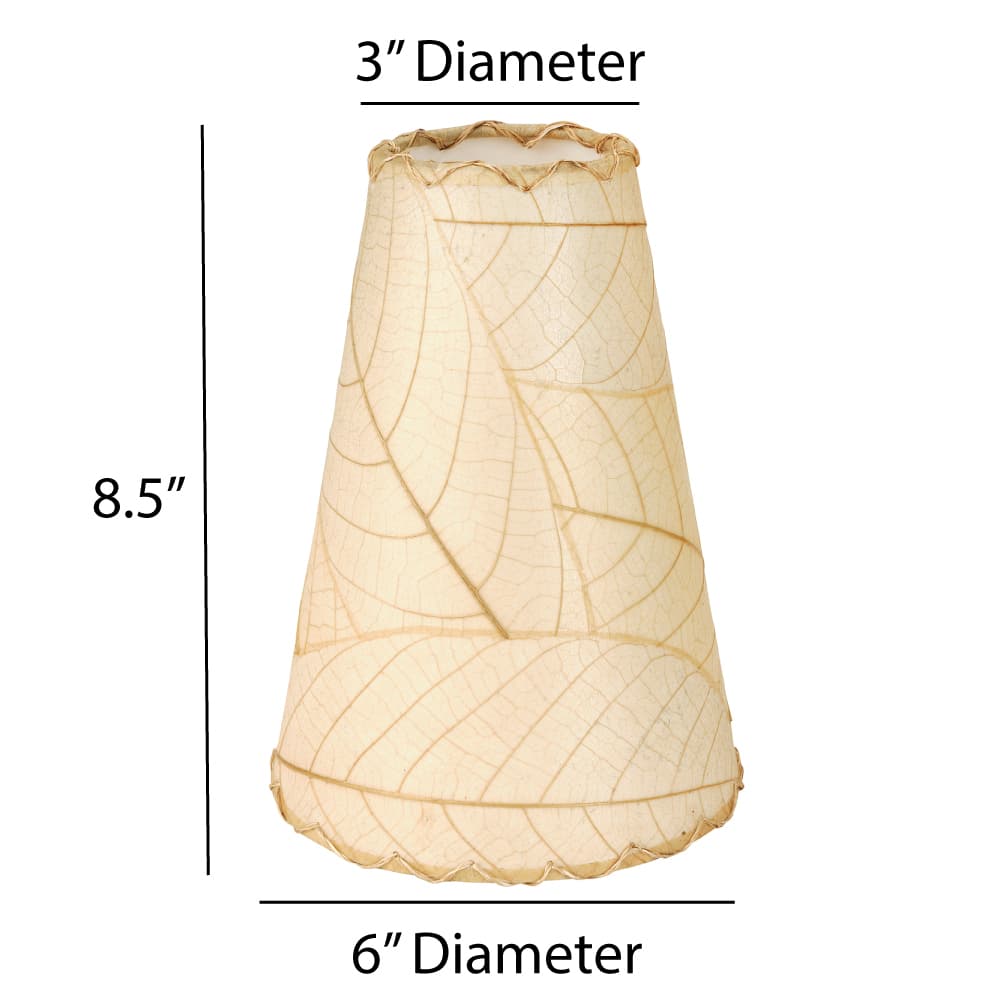
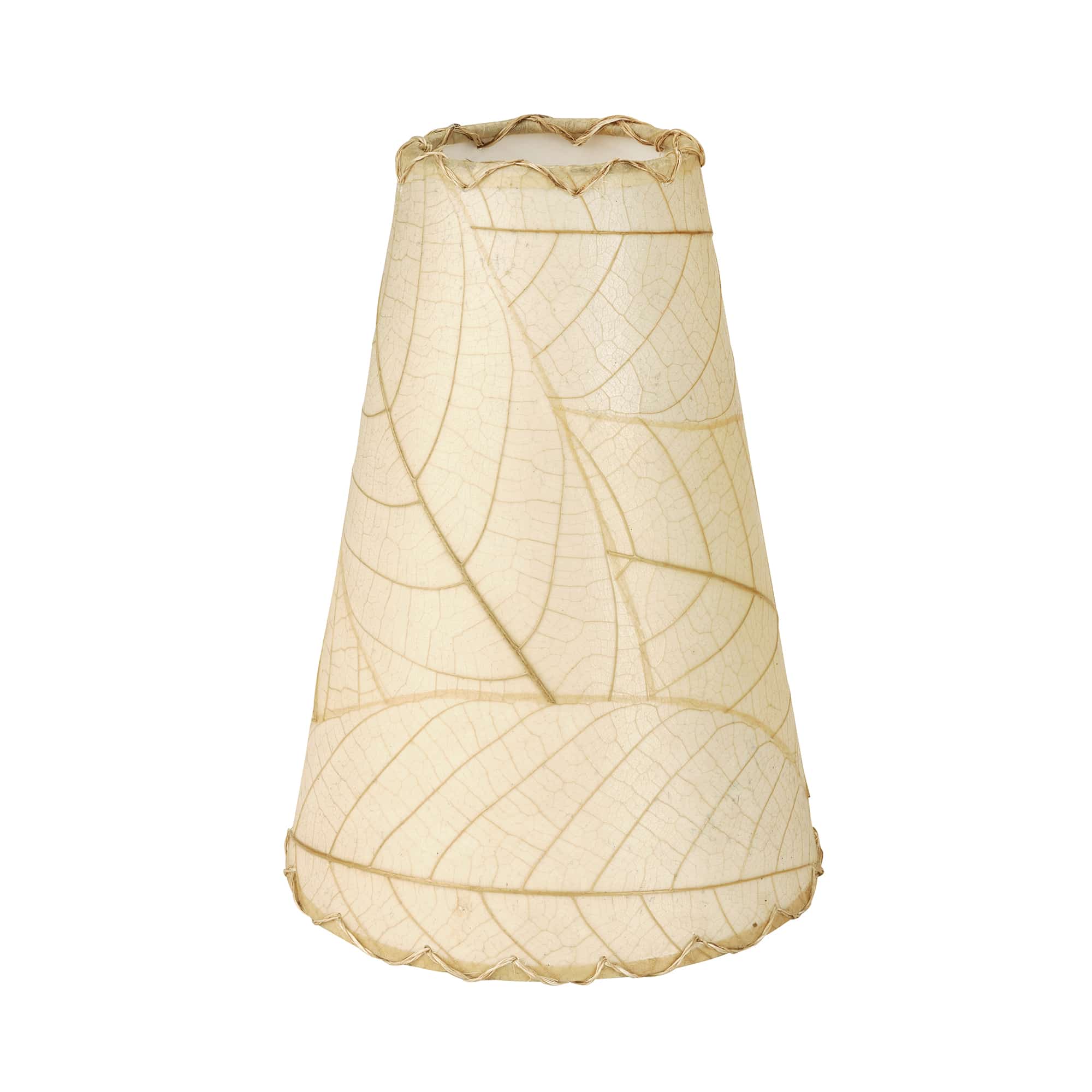 Replacement Shade Only The Gecko Wall lamp is a fun and whimsical piece designed to stand out. It can be hung as a bedside reading lamp, added as an accent light in the family room or even suction cupped to the window in a sunroom providing a 360 degree view. Shade features a standard UL lamp backing with fossilized cocoa leaves that are hand-placed and then laminated. The shade is handstiched onto a powder coated, wrought iron frame.
Replacement Shade Only The Gecko Wall lamp is a fun and whimsical piece designed to stand out. It can be hung as a bedside reading lamp, added as an accent light in the family room or even suction cupped to the window in a sunroom providing a 360 degree view. Shade features a standard UL lamp backing with fossilized cocoa leaves that are hand-placed and then laminated. The shade is handstiched onto a powder coated, wrought iron frame. -
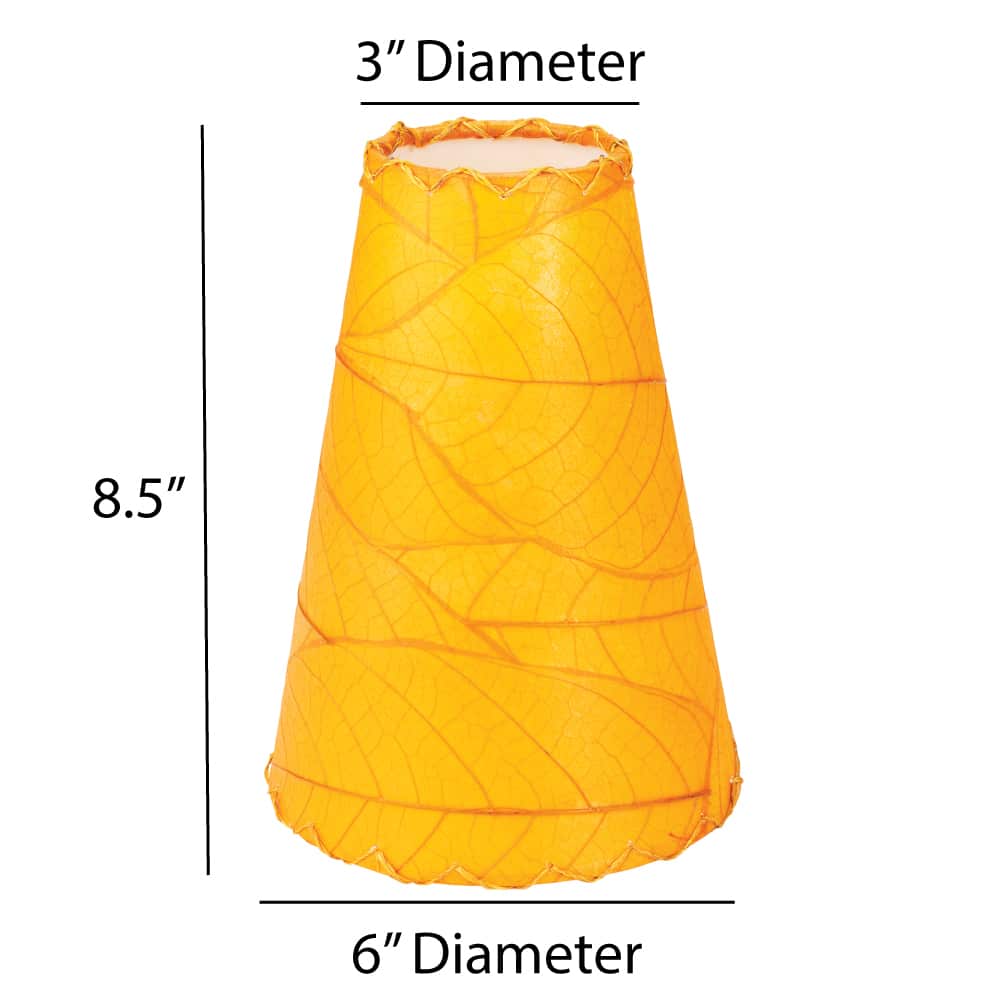
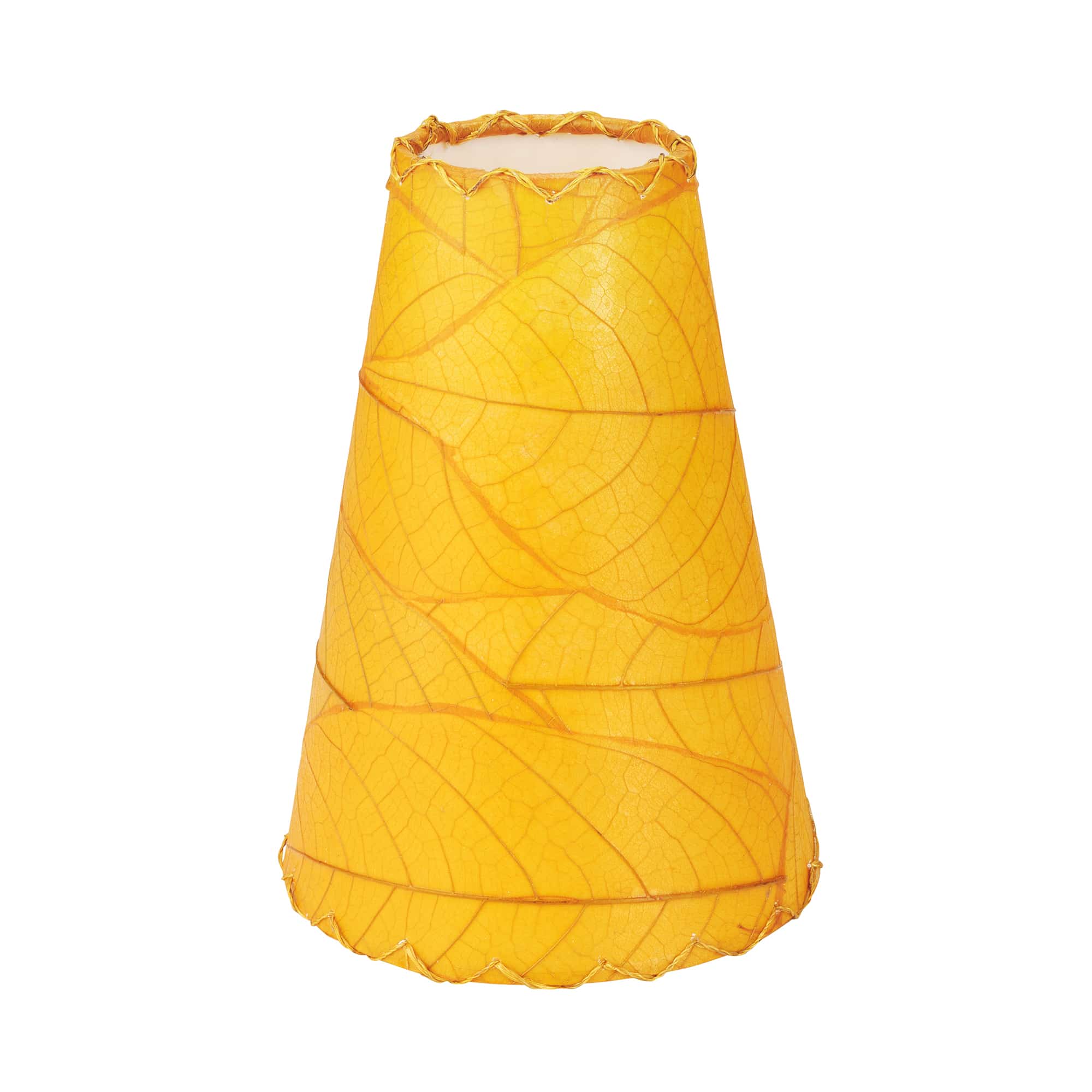 Replacement Shade Only The Gecko Wall lamp is a fun and whimsical piece designed to stand out. It can be hung as a bedside reading lamp, added as an accent light in the family room or even suction cupped to the window in a sunroom providing a 360 degree view. Shade features a standard UL lamp backing with fossilized cocoa leaves that are hand-placed and then laminated. The shade is handstiched onto a powder coated, wrought iron frame.
Replacement Shade Only The Gecko Wall lamp is a fun and whimsical piece designed to stand out. It can be hung as a bedside reading lamp, added as an accent light in the family room or even suction cupped to the window in a sunroom providing a 360 degree view. Shade features a standard UL lamp backing with fossilized cocoa leaves that are hand-placed and then laminated. The shade is handstiched onto a powder coated, wrought iron frame. -
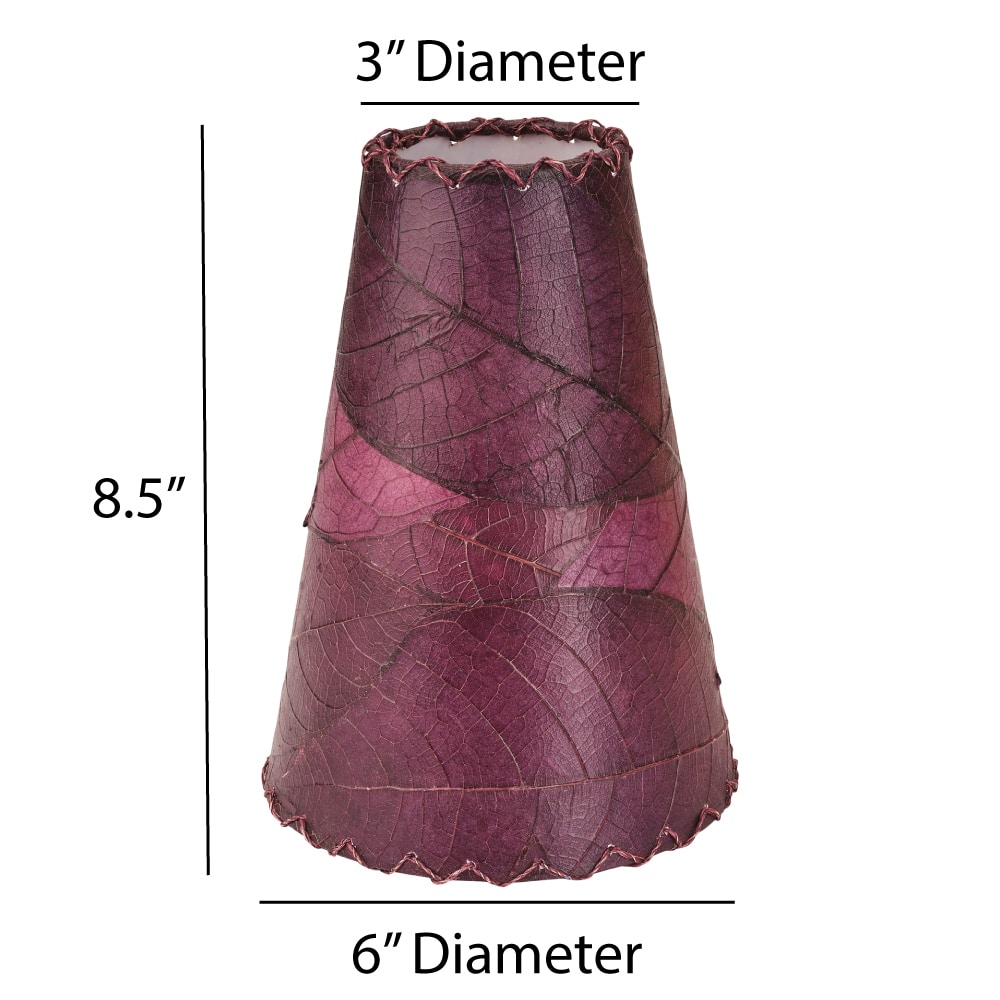
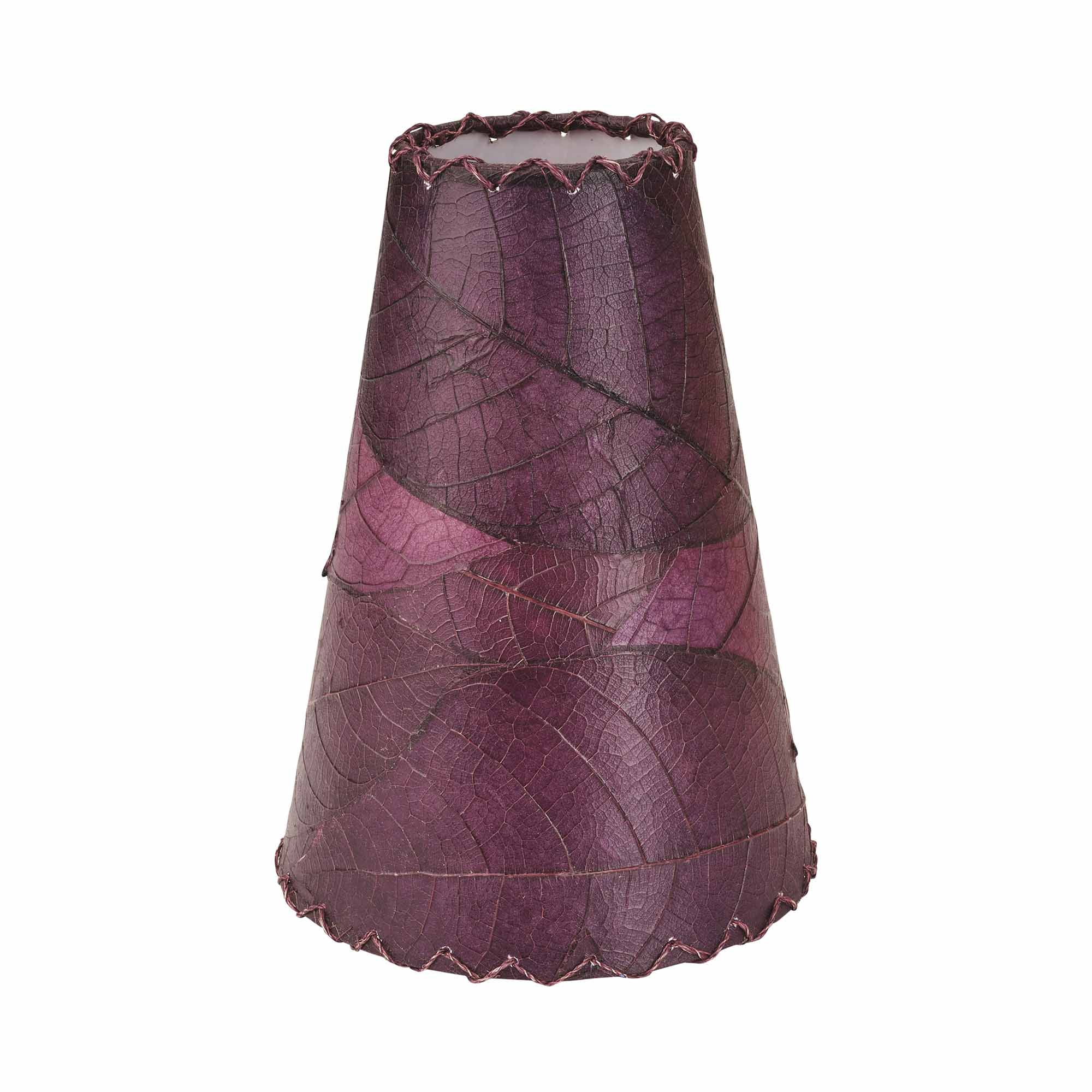 Replacement Shade Only The Gecko Wall lamp is a fun and whimsical piece designed to stand out. It can be hung as a bedside reading lamp, added as an accent light in the family room or even suction cupped to the window in a sunroom providing a 360 degree view. Shade features a standard UL lamp backing with fossilized cocoa leaves that are hand-placed and then laminated. The shade is handstiched onto a powder coated, wrought iron frame.
Replacement Shade Only The Gecko Wall lamp is a fun and whimsical piece designed to stand out. It can be hung as a bedside reading lamp, added as an accent light in the family room or even suction cupped to the window in a sunroom providing a 360 degree view. Shade features a standard UL lamp backing with fossilized cocoa leaves that are hand-placed and then laminated. The shade is handstiched onto a powder coated, wrought iron frame. -
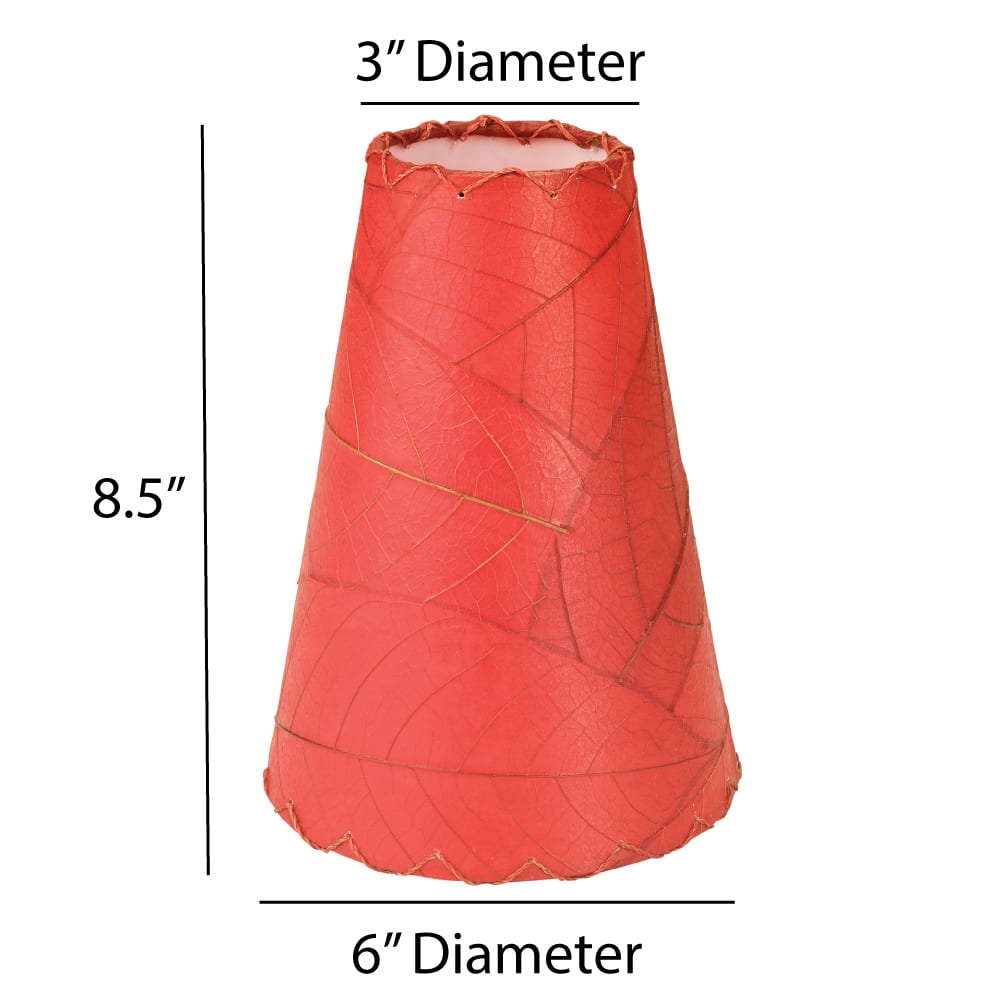
 Replacement Shade Only The Gecko Wall lamp is a fun and whimsical piece designed to stand out. It can be hung as a bedside reading lamp, added as an accent light in the family room or even suction cupped to the window in a sunroom providing a 360 degree view. Shade features a standard UL lamp backing with fossilized cocoa leaves that are hand-placed and then laminated. The shade is handstiched onto a powder coated, wrought iron frame.
Replacement Shade Only The Gecko Wall lamp is a fun and whimsical piece designed to stand out. It can be hung as a bedside reading lamp, added as an accent light in the family room or even suction cupped to the window in a sunroom providing a 360 degree view. Shade features a standard UL lamp backing with fossilized cocoa leaves that are hand-placed and then laminated. The shade is handstiched onto a powder coated, wrought iron frame. -
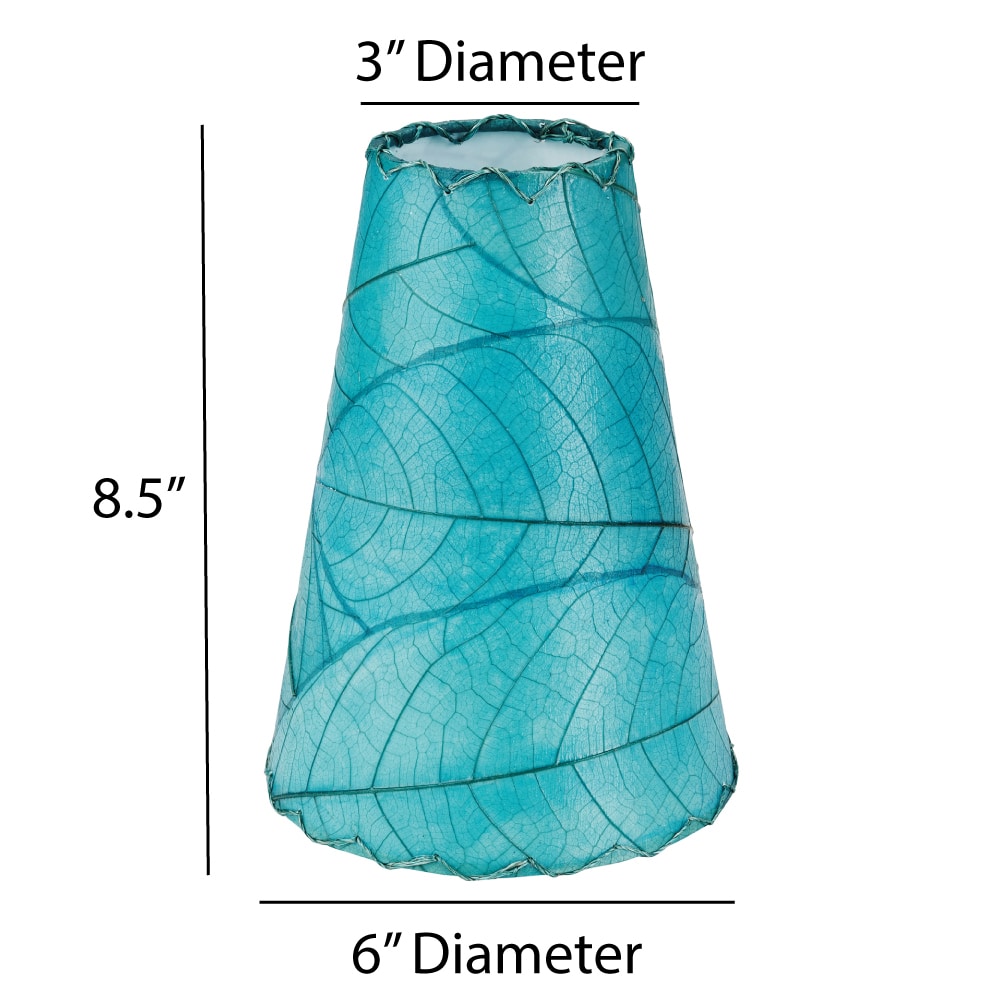
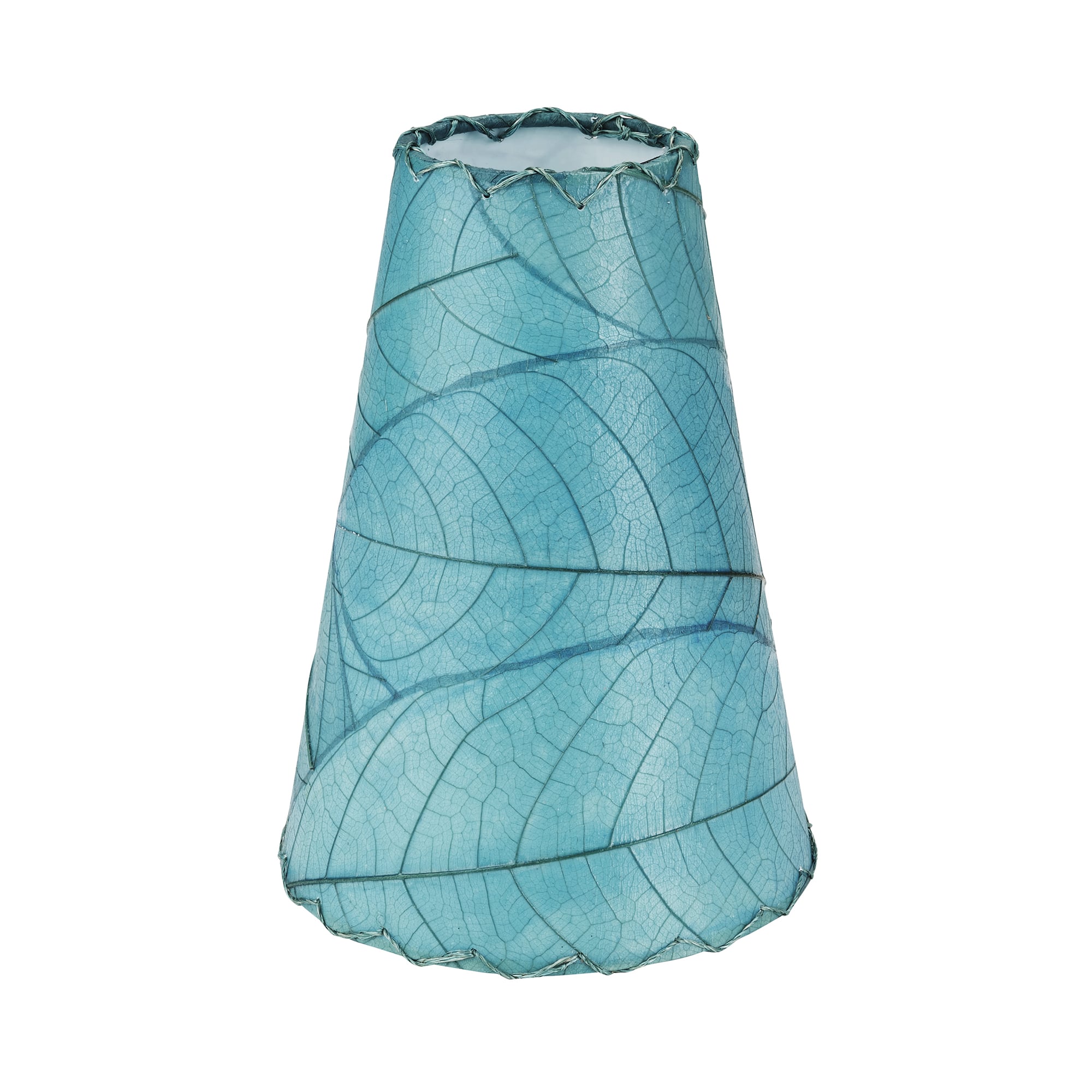 Replacement Shade Only The Gecko Wall lamp is a fun and whimsical piece designed to stand out. It can be hung as a bedside reading lamp, added as an accent light in the family room or even suction cupped to the window in a sunroom providing a 360 degree view. Shade features a standard UL lamp backing with fossilized cocoa leaves that are hand-placed and then laminated. The shade is handstiched onto a powder coated, wrought iron frame.
Replacement Shade Only The Gecko Wall lamp is a fun and whimsical piece designed to stand out. It can be hung as a bedside reading lamp, added as an accent light in the family room or even suction cupped to the window in a sunroom providing a 360 degree view. Shade features a standard UL lamp backing with fossilized cocoa leaves that are hand-placed and then laminated. The shade is handstiched onto a powder coated, wrought iron frame. -
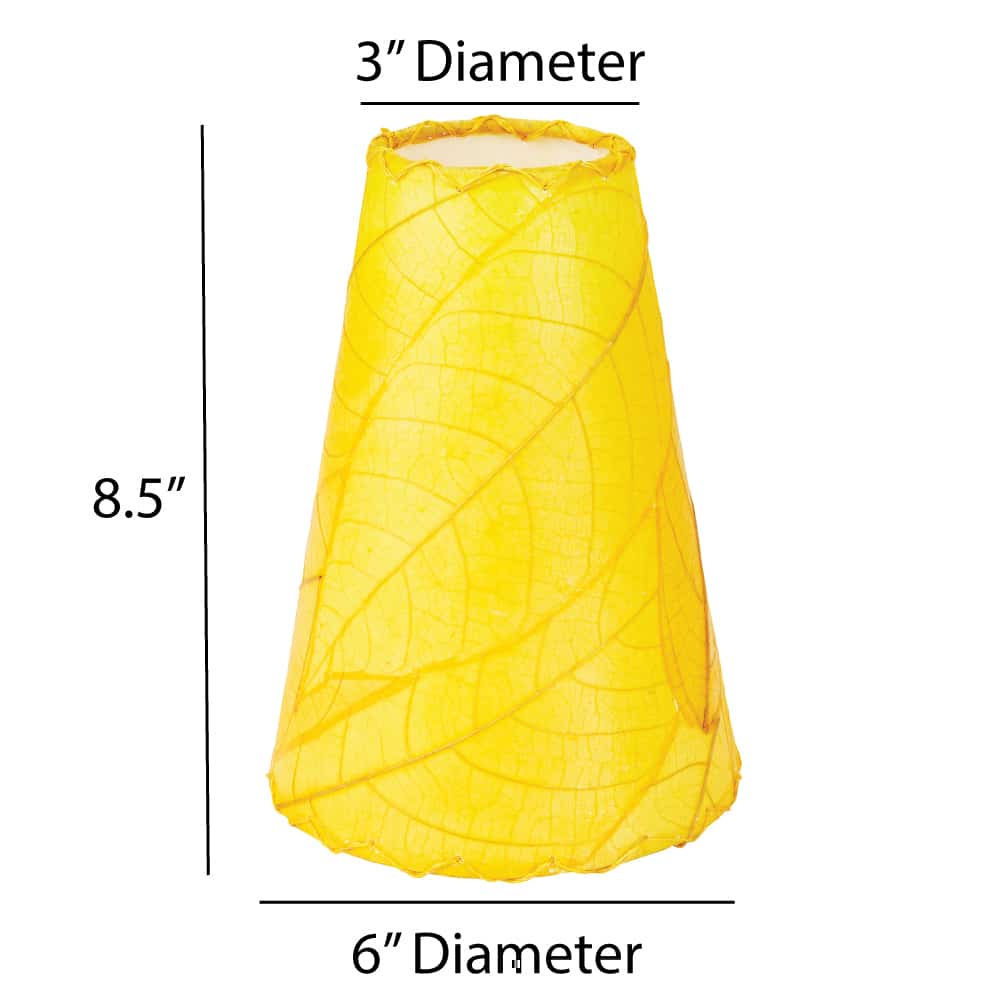
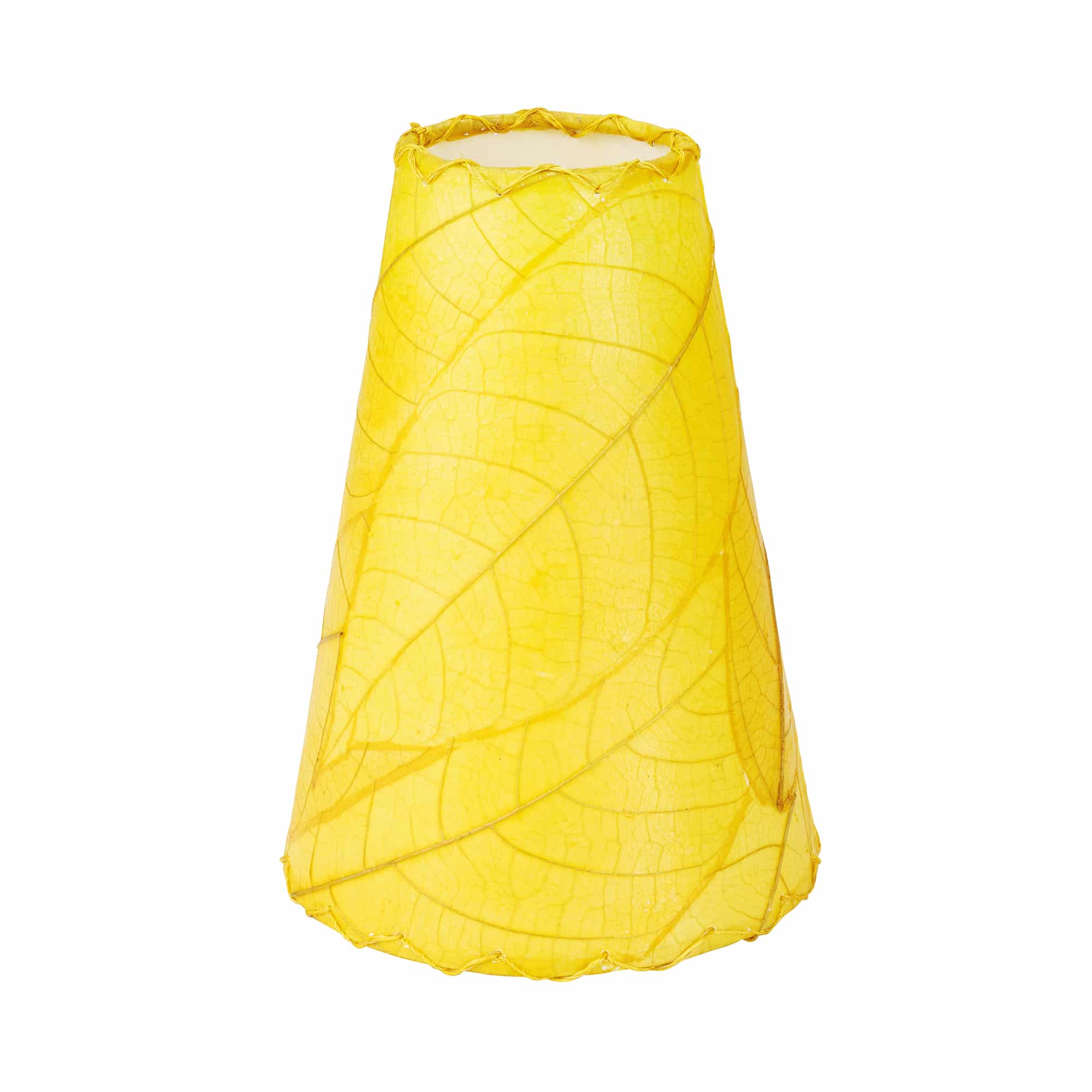 Replacement Shade Only The Gecko Wall lamp is a fun and whimsical piece designed to stand out. It can be hung as a bedside reading lamp, added as an accent light in the family room or even suction cupped to the window in a sunroom providing a 360 degree view. Shade features a standard UL lamp backing with fossilized cocoa leaves that are hand-placed and then laminated. The shade is handstiched onto a powder coated, wrought iron frame.
Replacement Shade Only The Gecko Wall lamp is a fun and whimsical piece designed to stand out. It can be hung as a bedside reading lamp, added as an accent light in the family room or even suction cupped to the window in a sunroom providing a 360 degree view. Shade features a standard UL lamp backing with fossilized cocoa leaves that are hand-placed and then laminated. The shade is handstiched onto a powder coated, wrought iron frame. -
-30%
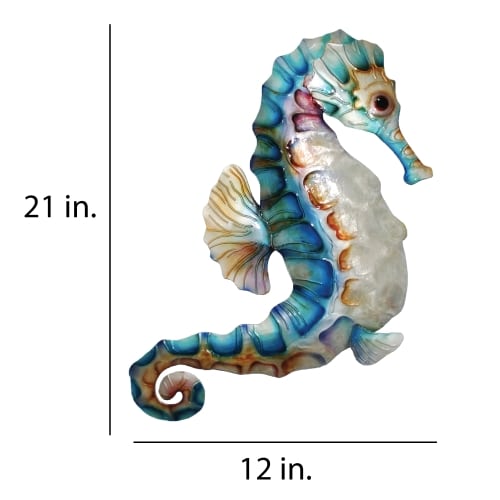
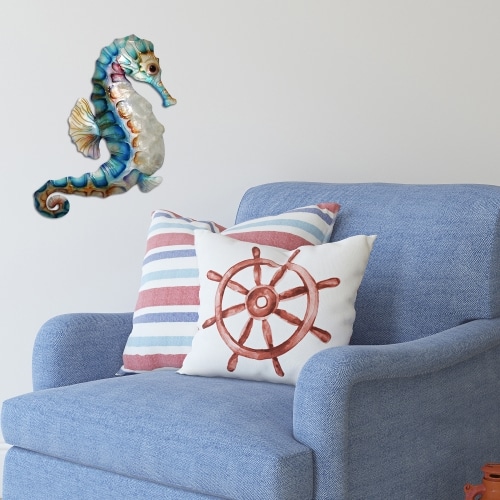 The Seahorse Wall Décor is a beautiful and unique addition to any home. The seahorse symbolizes discovery of balance in life and transformation of energy into positive thoughts. And because of the way seahorses move, they're also symbolic of peace and patience. The artist captures the splendor of the seahorse with a raised fin, high shine hand-painted finish, and capiz oyster shell chest and forefront. The Seahorse Wall Décor is the perfect way to bring good luck, strength, and beauty into your home. The basic frame of the Seahorse is created using tin, which is powder-coated with a black finish and makes this piece safe to use outdoors. The edges of the frame are reinforced using thicker tin wire. The front of this piece is adorned in areas with capiz shell, an oyster native to the Philippines, before being hand-painted and sealed with a water-based sealant. The primary purpose of this oyster to provide a source of food, however, the shell is a sustainable by-product that can be used for decoration. The capiz shell subtly replicates the reflective qualities of seahorses in nature. The entire piece is lightweight and has an eyelet in the back allowing it to be hung using a finishing nail, command strip, or a push pin. Due to it being a natural material, the organic colors of capiz come through as tans and browns underneath the paint.
The Seahorse Wall Décor is a beautiful and unique addition to any home. The seahorse symbolizes discovery of balance in life and transformation of energy into positive thoughts. And because of the way seahorses move, they're also symbolic of peace and patience. The artist captures the splendor of the seahorse with a raised fin, high shine hand-painted finish, and capiz oyster shell chest and forefront. The Seahorse Wall Décor is the perfect way to bring good luck, strength, and beauty into your home. The basic frame of the Seahorse is created using tin, which is powder-coated with a black finish and makes this piece safe to use outdoors. The edges of the frame are reinforced using thicker tin wire. The front of this piece is adorned in areas with capiz shell, an oyster native to the Philippines, before being hand-painted and sealed with a water-based sealant. The primary purpose of this oyster to provide a source of food, however, the shell is a sustainable by-product that can be used for decoration. The capiz shell subtly replicates the reflective qualities of seahorses in nature. The entire piece is lightweight and has an eyelet in the back allowing it to be hung using a finishing nail, command strip, or a push pin. Due to it being a natural material, the organic colors of capiz come through as tans and browns underneath the paint. -
-30%
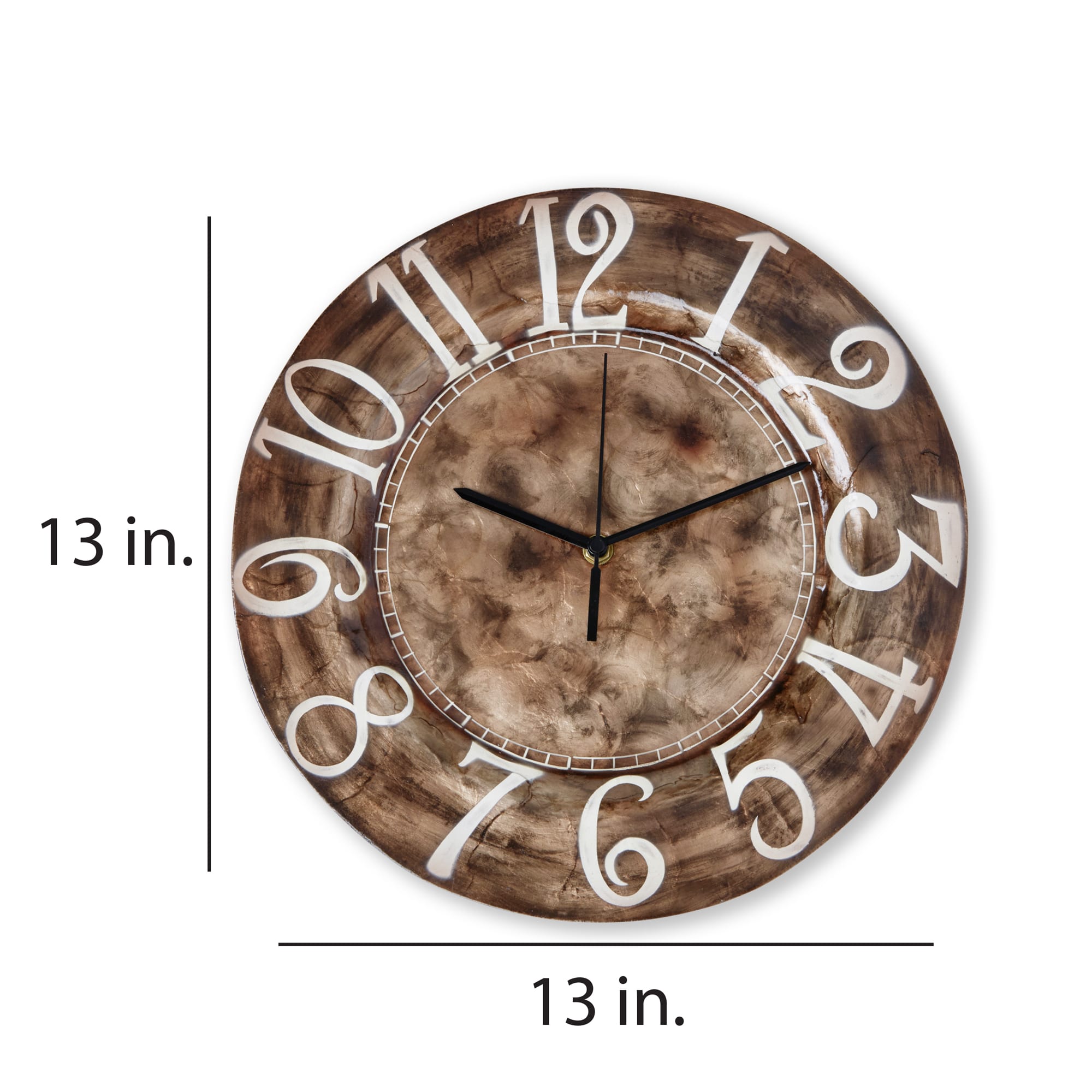
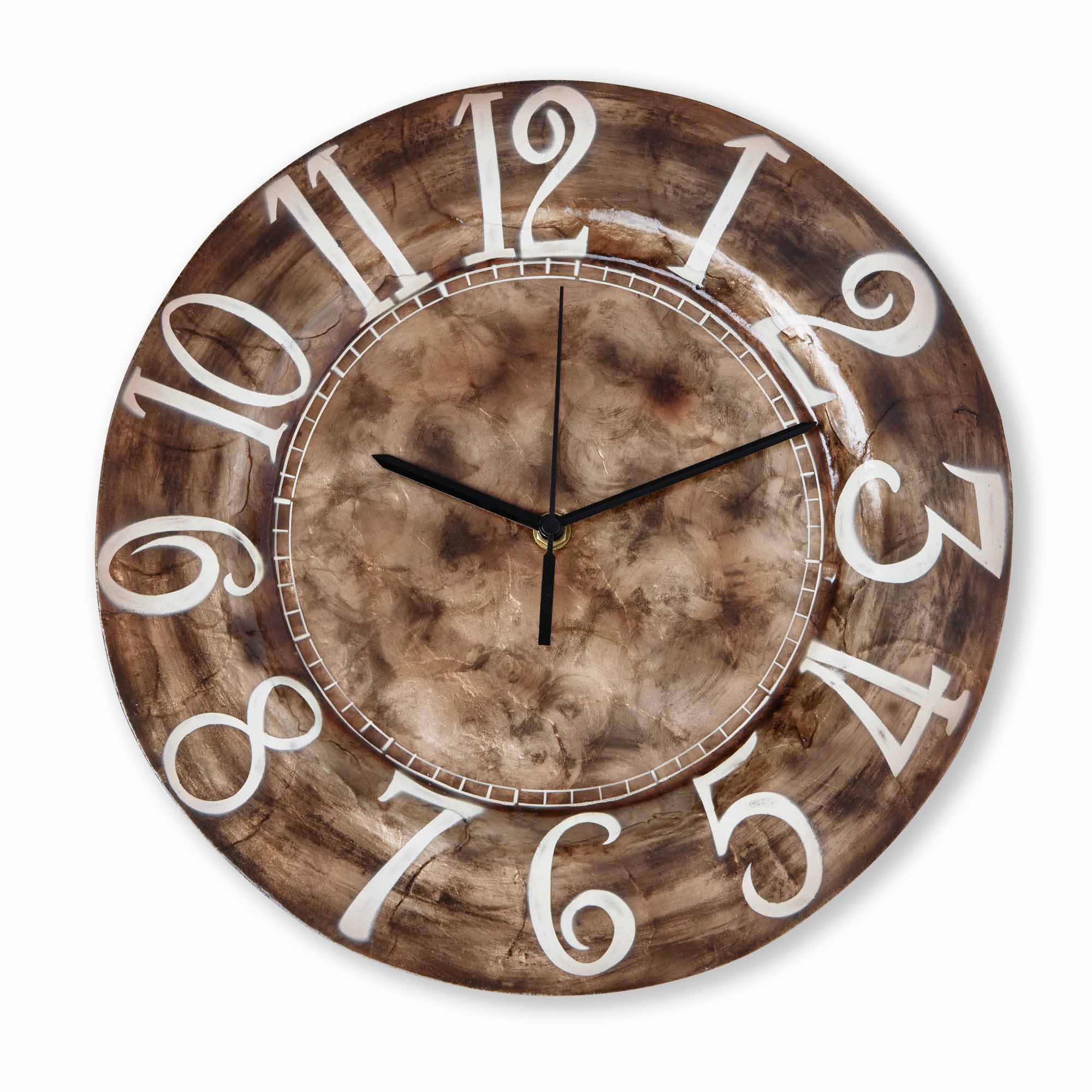 The frame of this clock is made with solid capiz oyster shell, compressed into shape. The texture and lines of the individual shell pieces still come through the broad brush strokes of brown on the background of the clock. The distressed look of the earthy, rich background color giving an aged feel which is complemented by the added detail of the weathered, hand-painted numbers. Capiz is an oyster shell and the primary purpose of the oyster is as a source of food. However, the by-product, the shell, can be used for decoration. The clock is created by compressing capiz shell together and forming it into shape. The final result is a light-weight, plate that feels similar to plastic. Due to it being a natural material, the natural colors of the capiz may come through as tans and browns underneath the hand-painted surface.
The frame of this clock is made with solid capiz oyster shell, compressed into shape. The texture and lines of the individual shell pieces still come through the broad brush strokes of brown on the background of the clock. The distressed look of the earthy, rich background color giving an aged feel which is complemented by the added detail of the weathered, hand-painted numbers. Capiz is an oyster shell and the primary purpose of the oyster is as a source of food. However, the by-product, the shell, can be used for decoration. The clock is created by compressing capiz shell together and forming it into shape. The final result is a light-weight, plate that feels similar to plastic. Due to it being a natural material, the natural colors of the capiz may come through as tans and browns underneath the hand-painted surface. -
-30%
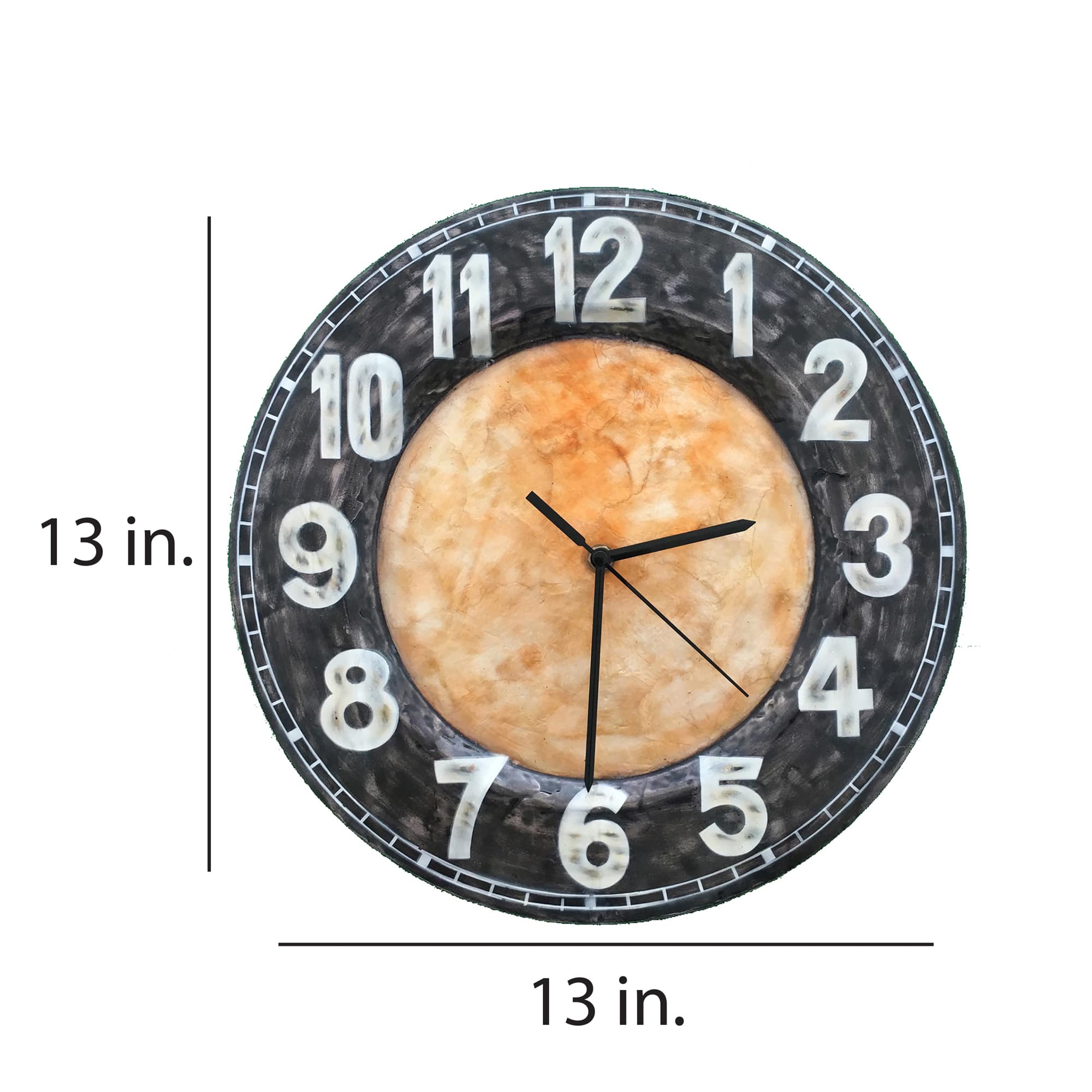
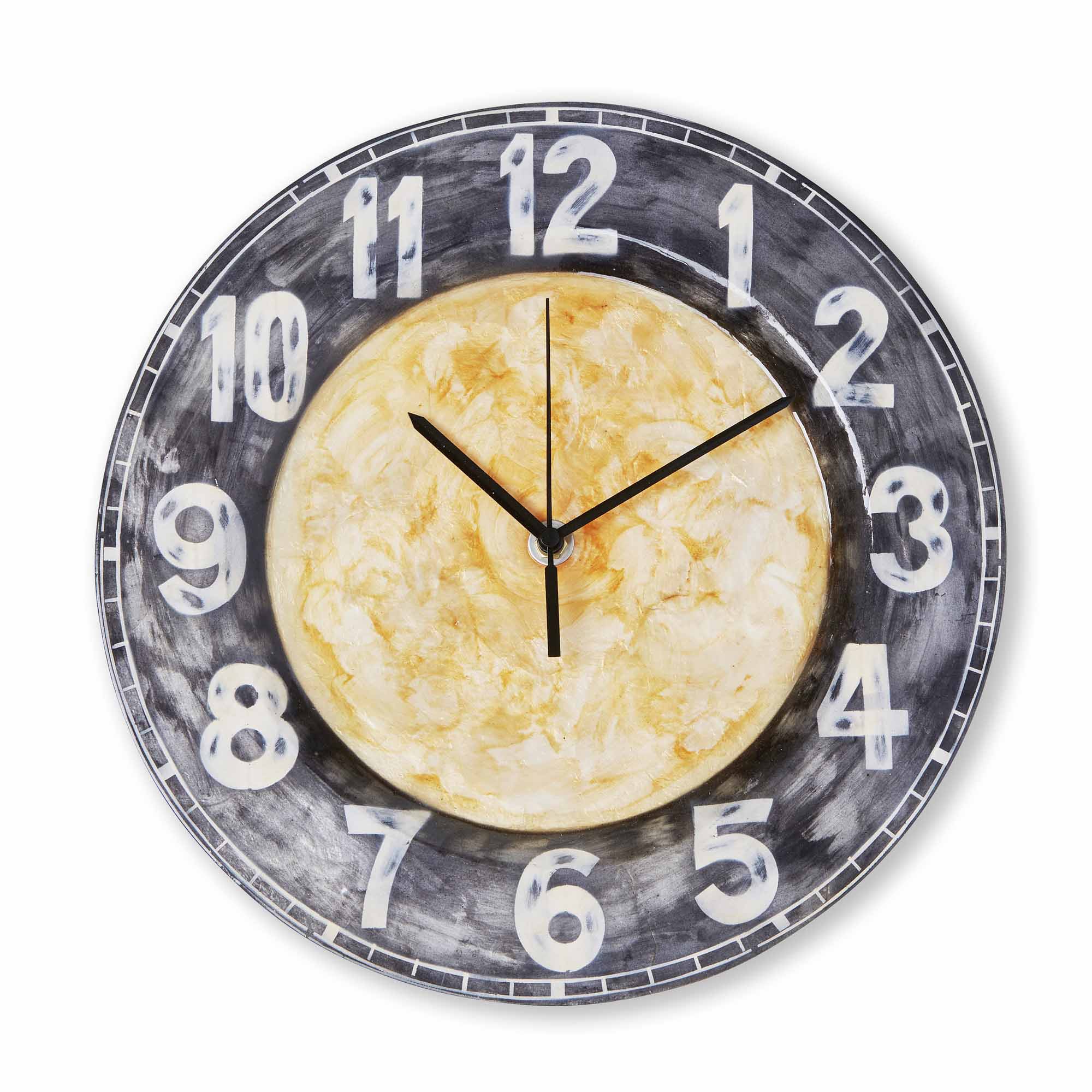 The frame of this clock is made with solid capiz oyster shell, compressed into shape. The texture and lines of the individual shell pieces still come through the hand-painted clock face. The center of the clock is sponge-painted resembling a Mediterranean, terra cotta finish. The darker outer rim and contrasting white, weathered numbers, complete this piece to feel as though it came from the old world. Capiz is an oyster shell and the primary purpose of the oyster is as a source of food. However, the by-product, the shell, can be used for decoration. The clock is created by compressing capiz shell together and forming it into shape. The final result is a light-weight, plate that feels similar to plastic. Due to it being a natural material, the natural colors of the capiz may come through as tans and browns underneath the hand-painted surface.
The frame of this clock is made with solid capiz oyster shell, compressed into shape. The texture and lines of the individual shell pieces still come through the hand-painted clock face. The center of the clock is sponge-painted resembling a Mediterranean, terra cotta finish. The darker outer rim and contrasting white, weathered numbers, complete this piece to feel as though it came from the old world. Capiz is an oyster shell and the primary purpose of the oyster is as a source of food. However, the by-product, the shell, can be used for decoration. The clock is created by compressing capiz shell together and forming it into shape. The final result is a light-weight, plate that feels similar to plastic. Due to it being a natural material, the natural colors of the capiz may come through as tans and browns underneath the hand-painted surface. -
-30%
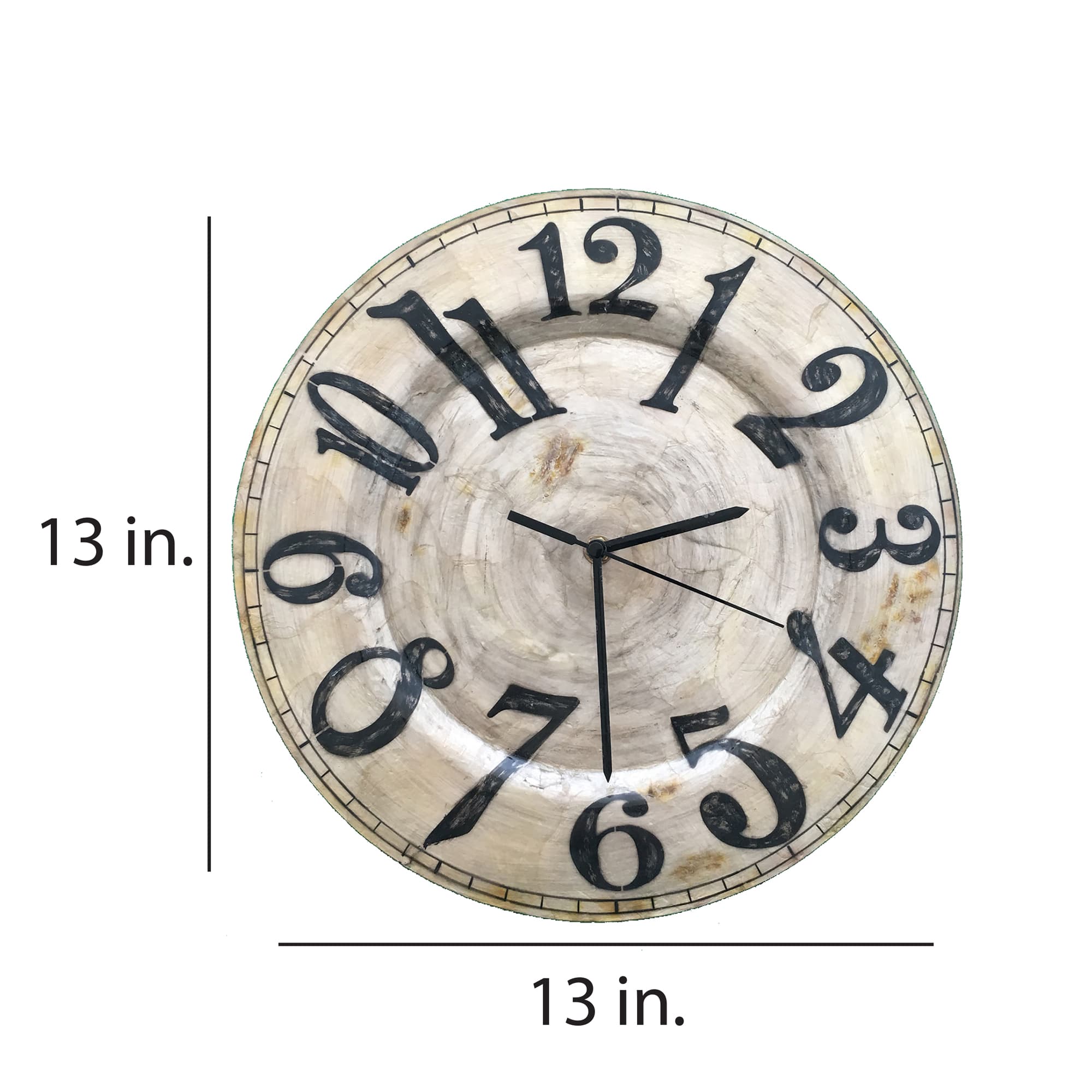
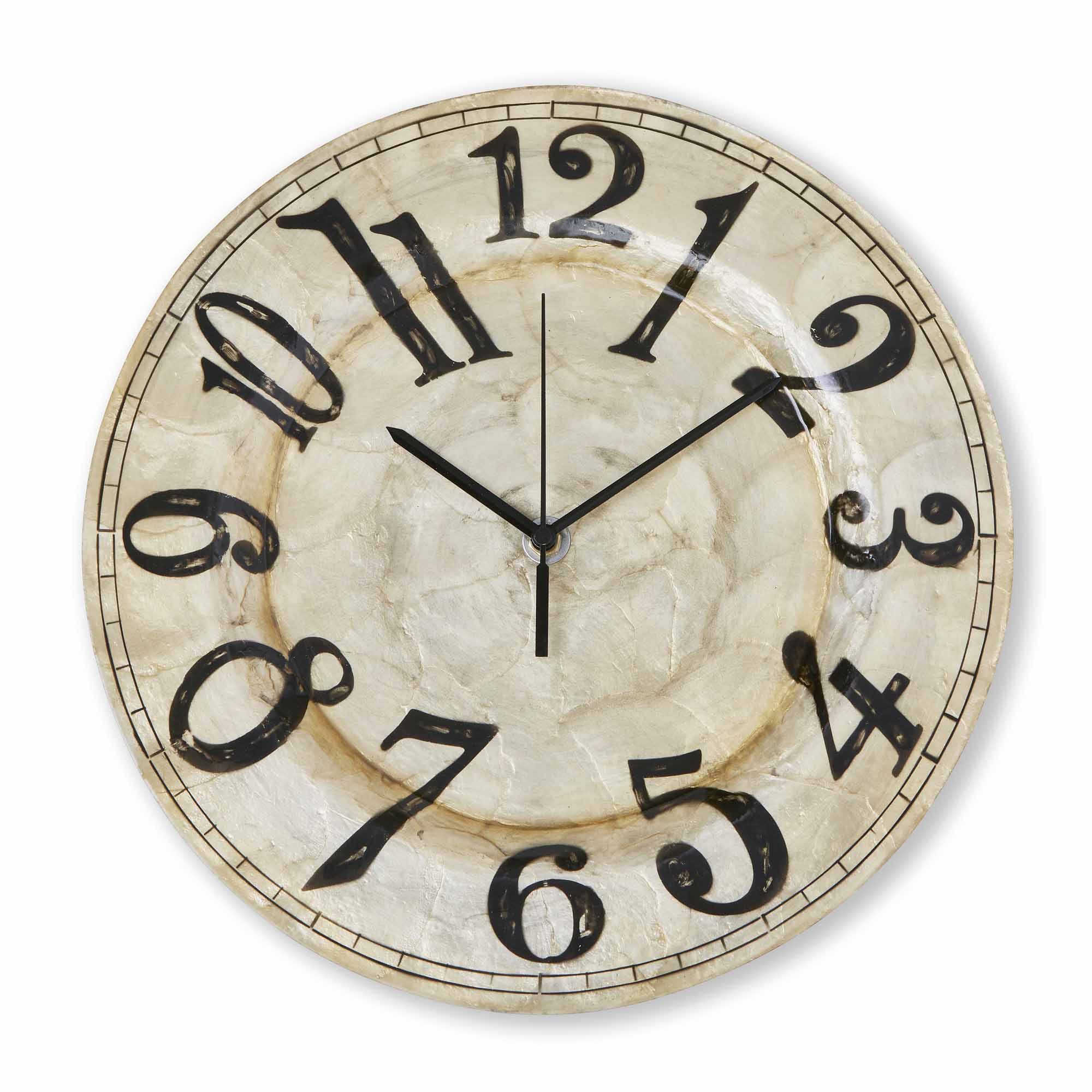 The frame of this clock is made with solid capiz oyster shell, compressed into shape. The face is hand-painted to appear as if it is aged porcelain, promoted by the natual colors of the capiz shell. The look is further accentuated by gentle distressed marks. The black, bold numbers vary in size and stand in strong contrast to the pearl background. The combination of simple color palette and the seasoned feel of the porcelain finish are quintessential hallmarks of the modern farmhouse design genre. Capiz is an oyster shell and the primary purpose of the oyster is as a source of food. However, the by-product, the shell, can be used for decoration. The clock is created by compressing capiz shell together and forming it into shape. The final result is a light-weight, plate that feels similar to plastic. Due to it being a natural material, the natural colors of the capiz may come through as tans and browns underneath the hand-painted surface.
The frame of this clock is made with solid capiz oyster shell, compressed into shape. The face is hand-painted to appear as if it is aged porcelain, promoted by the natual colors of the capiz shell. The look is further accentuated by gentle distressed marks. The black, bold numbers vary in size and stand in strong contrast to the pearl background. The combination of simple color palette and the seasoned feel of the porcelain finish are quintessential hallmarks of the modern farmhouse design genre. Capiz is an oyster shell and the primary purpose of the oyster is as a source of food. However, the by-product, the shell, can be used for decoration. The clock is created by compressing capiz shell together and forming it into shape. The final result is a light-weight, plate that feels similar to plastic. Due to it being a natural material, the natural colors of the capiz may come through as tans and browns underneath the hand-painted surface. -
-30%
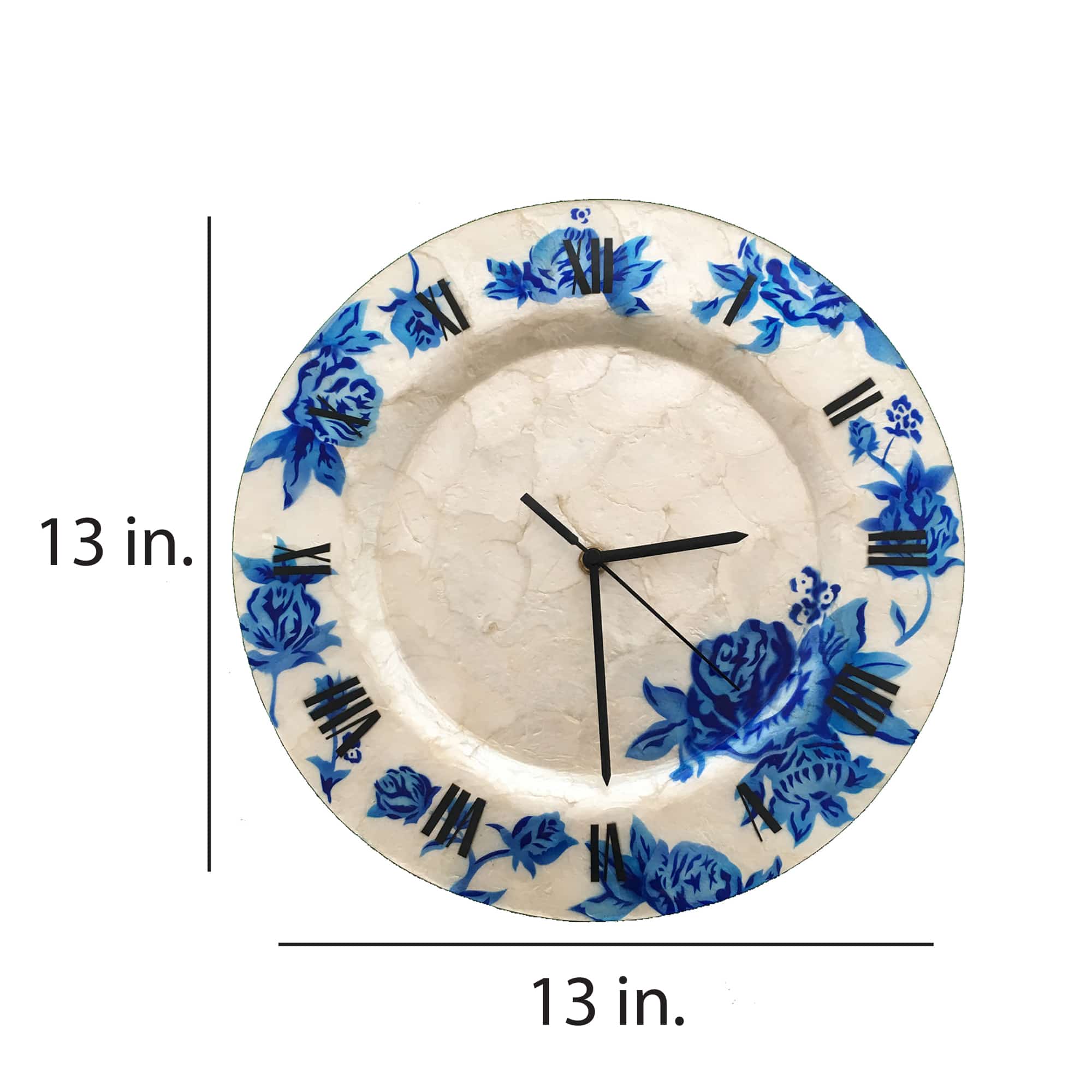
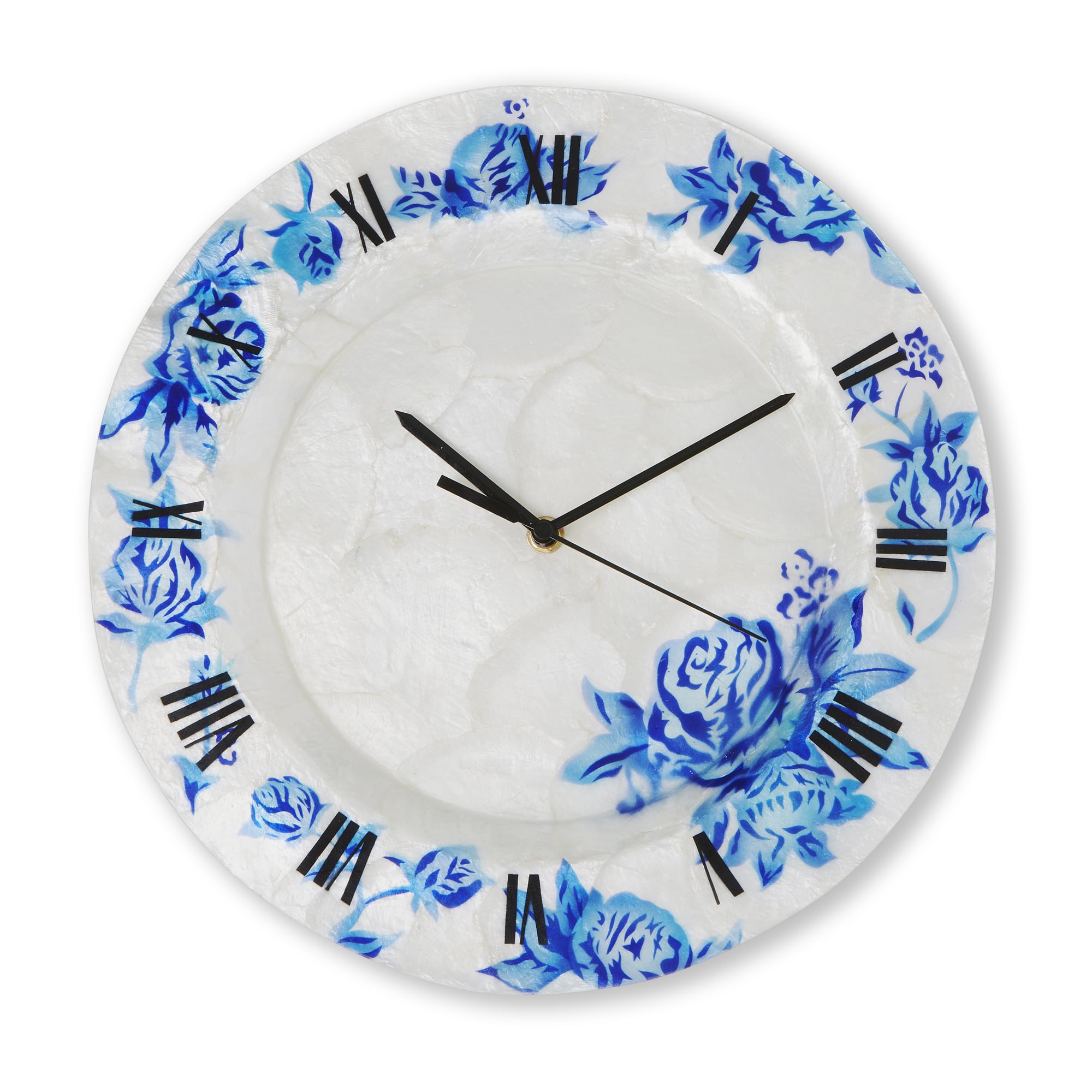 The frame of this clock is made with solid capiz oyster shell, compressed into shape. The artist seals the shells, leaving the natural color of the capiz as the base, pearl color of the clock face. Intricately designed blue roses are hand-painted and purposefully placed along the outer rim. Bold roman numberals are evenly spaced to complement the strong floral design. The combination provides a strong vintage appeal. Capiz is an oyster shell and the primary purpose of the oyster is as a source of food. However, the by-product, the shell, can be used for decoration. The clock is created by compressing capiz shell together and forming it into shape. The final result is a light-weight, plate that feels similar to plastic. Due to it being a natural material, the natural colors of the capiz may come through as tans and browns underneath the hand-painted surface.
The frame of this clock is made with solid capiz oyster shell, compressed into shape. The artist seals the shells, leaving the natural color of the capiz as the base, pearl color of the clock face. Intricately designed blue roses are hand-painted and purposefully placed along the outer rim. Bold roman numberals are evenly spaced to complement the strong floral design. The combination provides a strong vintage appeal. Capiz is an oyster shell and the primary purpose of the oyster is as a source of food. However, the by-product, the shell, can be used for decoration. The clock is created by compressing capiz shell together and forming it into shape. The final result is a light-weight, plate that feels similar to plastic. Due to it being a natural material, the natural colors of the capiz may come through as tans and browns underneath the hand-painted surface. -
-30%
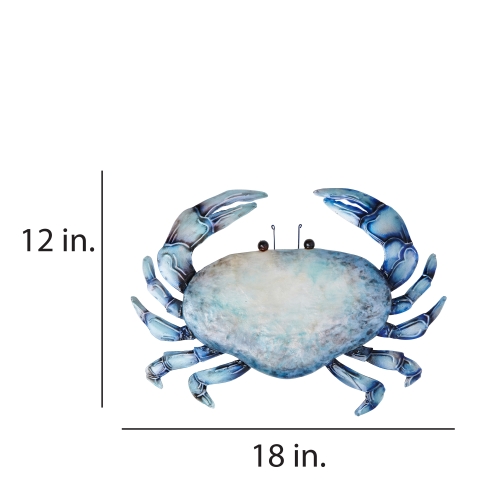
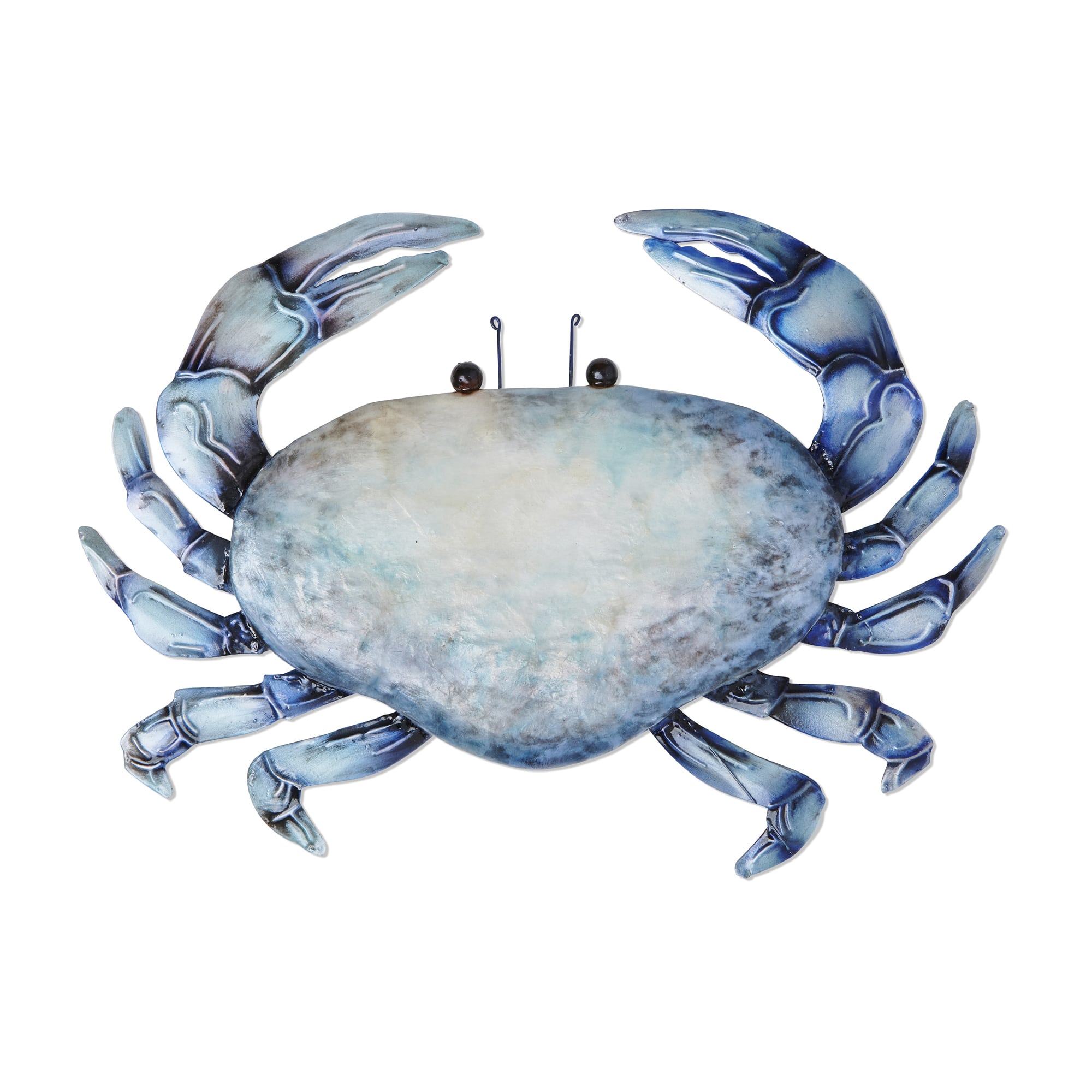 The frame of the piece is an Emerald Crab, which are commonly found in tropical waters of the Caribbean Sea. The maritime blue colors reflect the waters of its natural habitat while exhibiting calm and cool colors. The artist also creates slight contrasts between the body of the crab using capiz oyster shells and the matted outer legs and pinchers. The body will reflect light making it seem bolder. The basic frame of this piece is created using tin, which is powder coated with a black finish. The frame is reinforced using tin wire along the inner edge. The front of the body is adorned with capiz. Capiz is an oyster shell and the primary purpose of the oyster is as a source of food. However, the by-product, the shell, can be used for decoration. Due to it being a natural material, the natural colors of the capiz may come through as tans and browns underneath the hand-painted surface.
The frame of the piece is an Emerald Crab, which are commonly found in tropical waters of the Caribbean Sea. The maritime blue colors reflect the waters of its natural habitat while exhibiting calm and cool colors. The artist also creates slight contrasts between the body of the crab using capiz oyster shells and the matted outer legs and pinchers. The body will reflect light making it seem bolder. The basic frame of this piece is created using tin, which is powder coated with a black finish. The frame is reinforced using tin wire along the inner edge. The front of the body is adorned with capiz. Capiz is an oyster shell and the primary purpose of the oyster is as a source of food. However, the by-product, the shell, can be used for decoration. Due to it being a natural material, the natural colors of the capiz may come through as tans and browns underneath the hand-painted surface. -
-30%
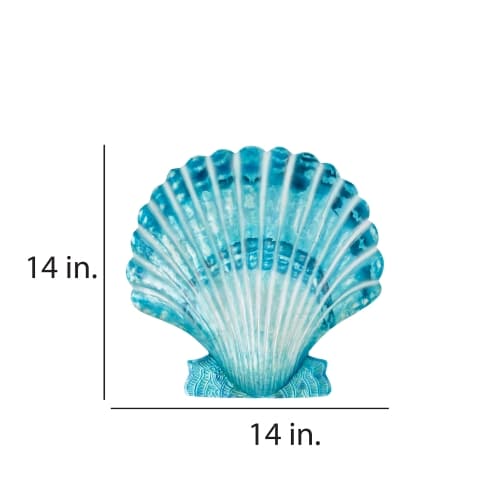
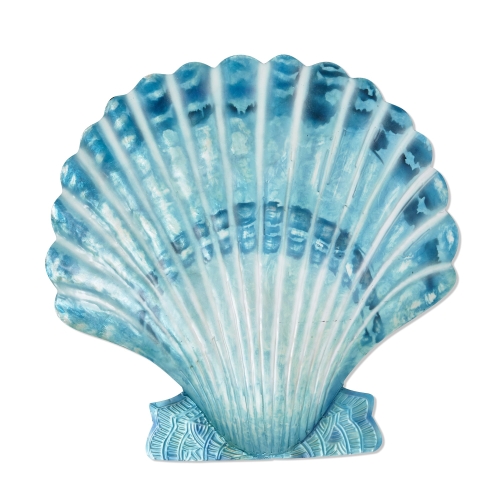 The design is based on the shape of the Senatorial scallop found in the tropical waters of the pacific. Like the rings of a tree, one can determine the age of a scallop my counting the rings on its shell. Each ring represents one year of growth. The artist using this feature to add beautiful detail along with a deep aqua color to reflect its ocean habitat. Real capiz oyster shell adorns the exterior giving this piece a shimmer as if light were bouncing off its shell from under water. The basic frame of this piece is created using tin, which is powder coated with a black finish. The frame is reinforced using tin wire along the inner edge. The front of the body is adorned with capiz. Capiz is an oyster shell and the primary purpose of the oyster is as a source of food. However, the by-product, the shell, can be used for decoration. Due to it being a natural material, the natural colors of the capiz may come through as tans and browns underneath the hand-painted surface.
The design is based on the shape of the Senatorial scallop found in the tropical waters of the pacific. Like the rings of a tree, one can determine the age of a scallop my counting the rings on its shell. Each ring represents one year of growth. The artist using this feature to add beautiful detail along with a deep aqua color to reflect its ocean habitat. Real capiz oyster shell adorns the exterior giving this piece a shimmer as if light were bouncing off its shell from under water. The basic frame of this piece is created using tin, which is powder coated with a black finish. The frame is reinforced using tin wire along the inner edge. The front of the body is adorned with capiz. Capiz is an oyster shell and the primary purpose of the oyster is as a source of food. However, the by-product, the shell, can be used for decoration. Due to it being a natural material, the natural colors of the capiz may come through as tans and browns underneath the hand-painted surface.









